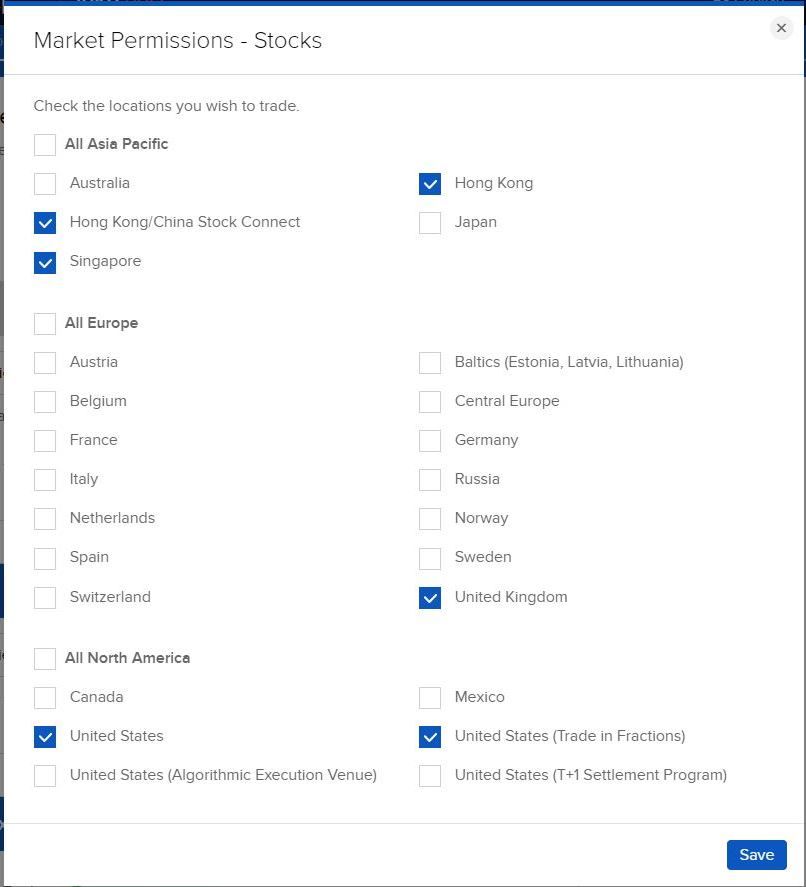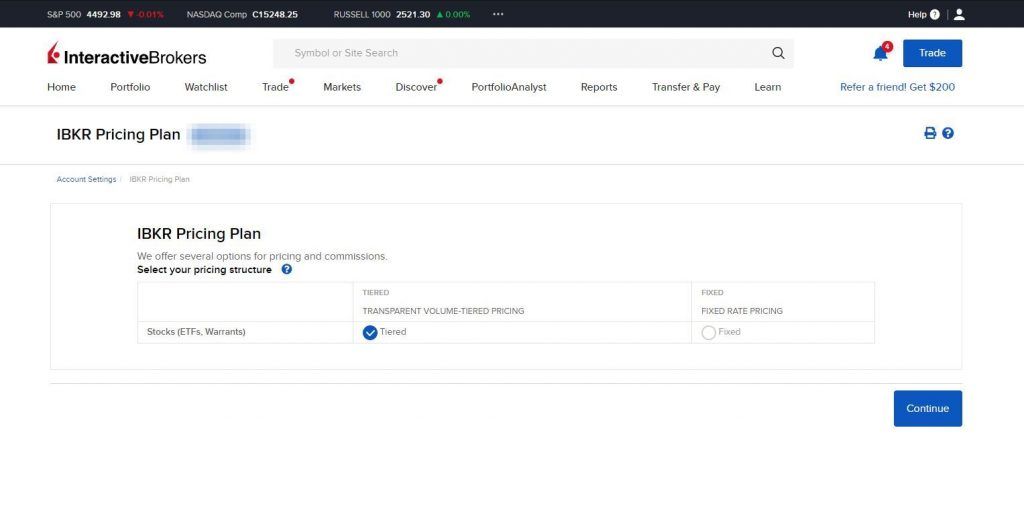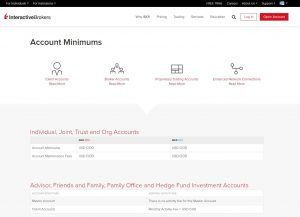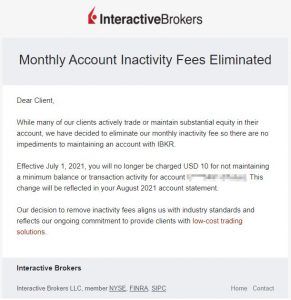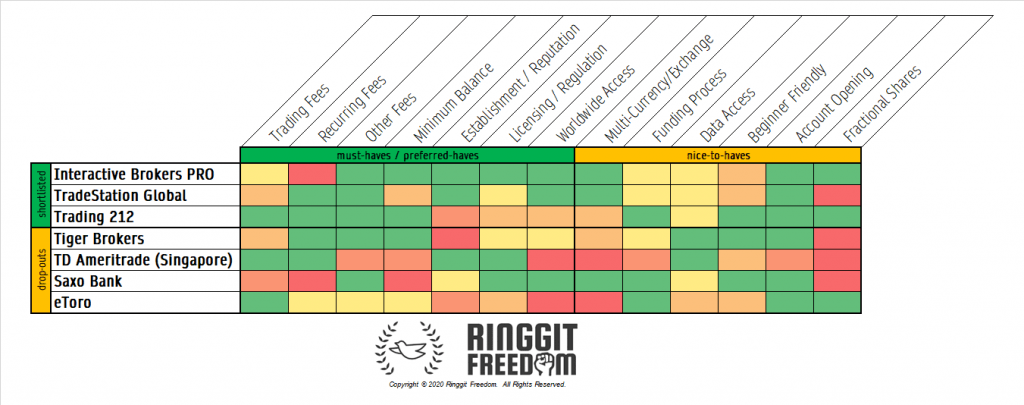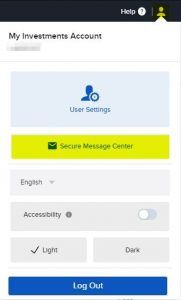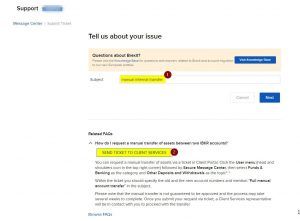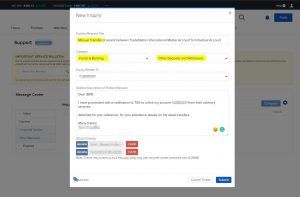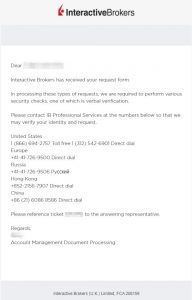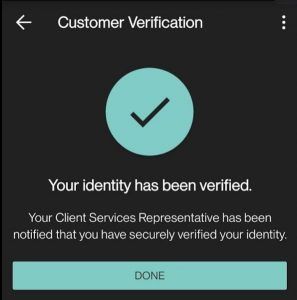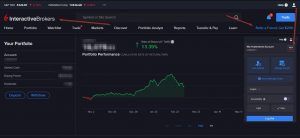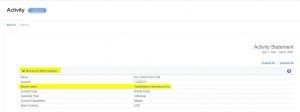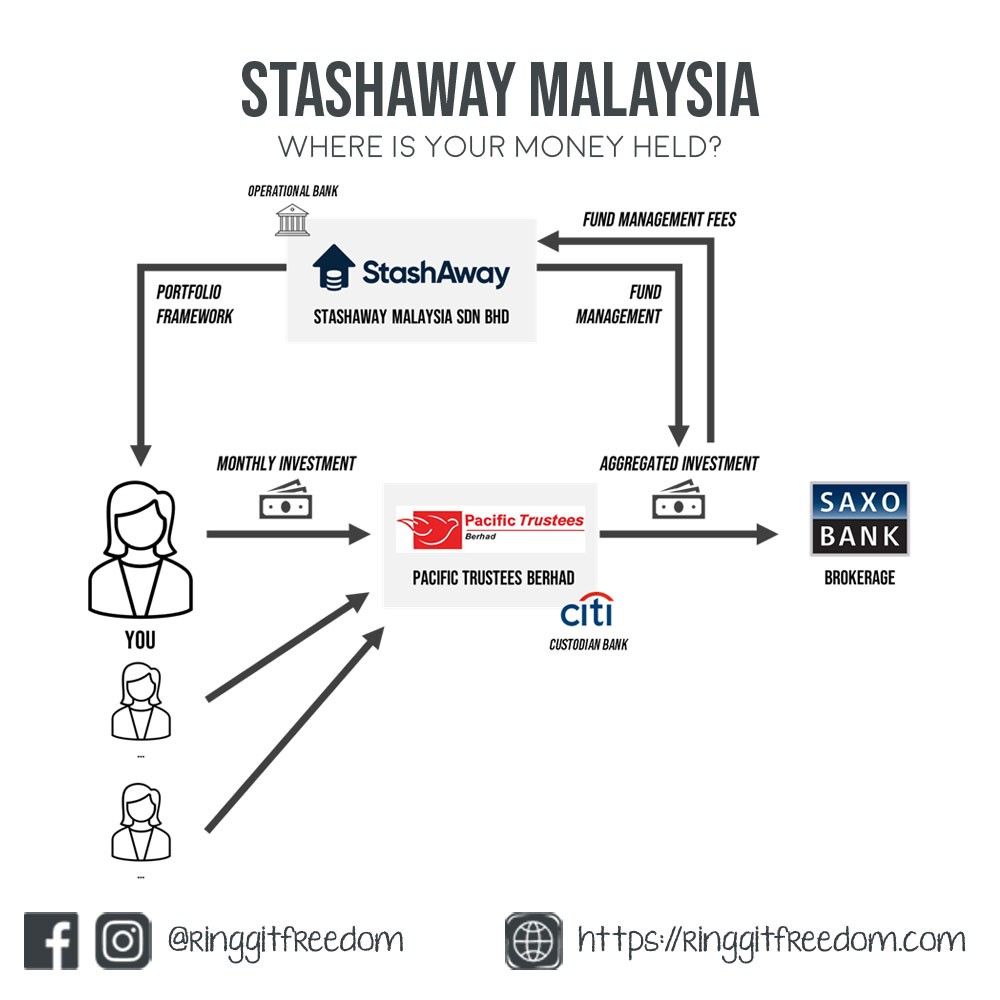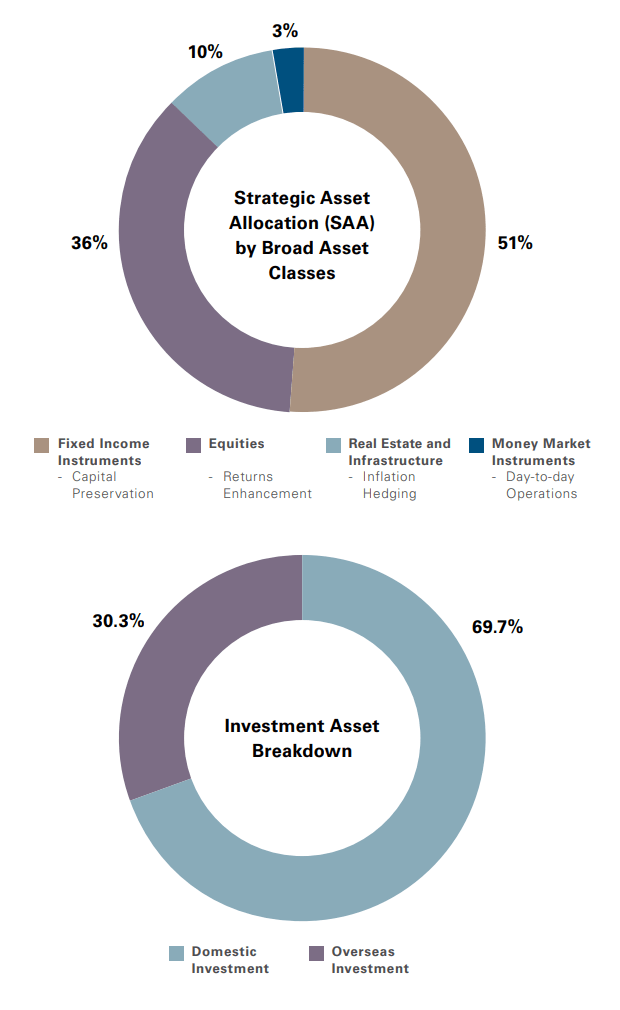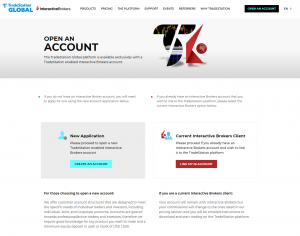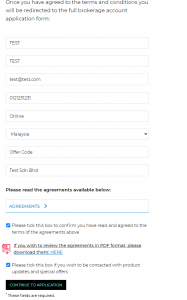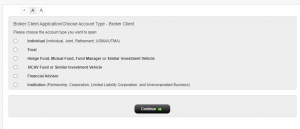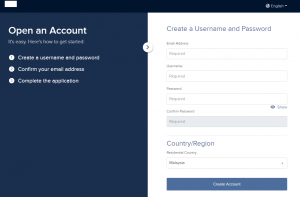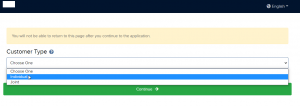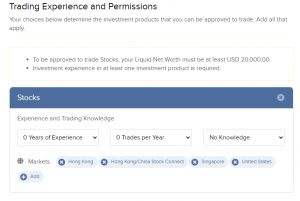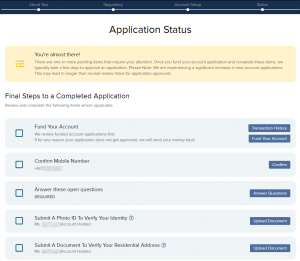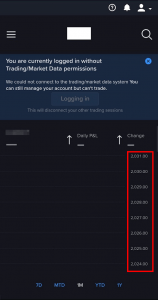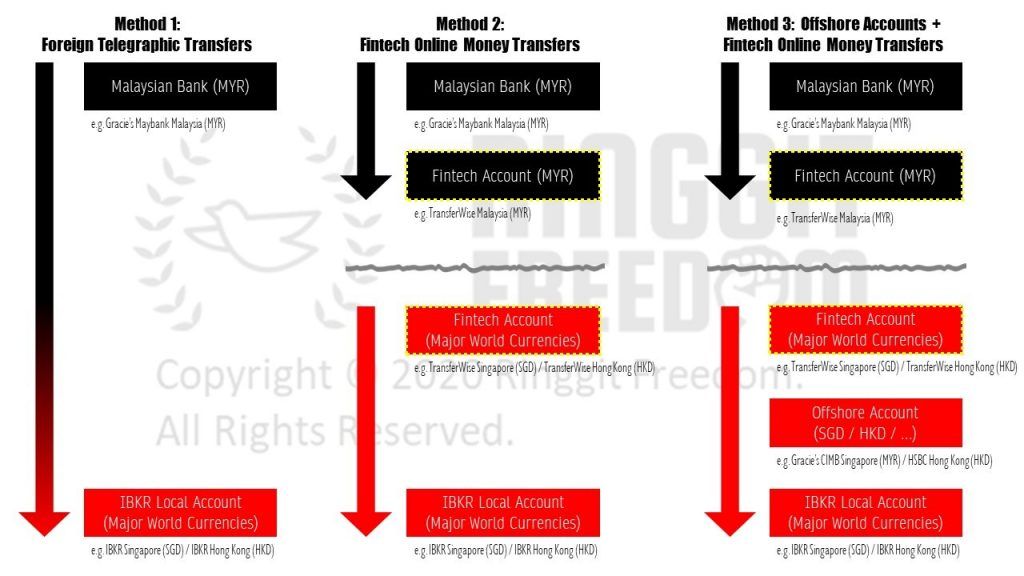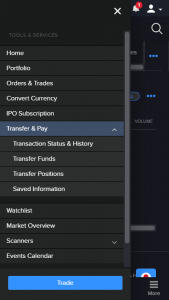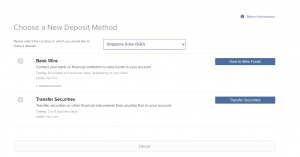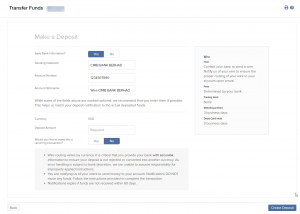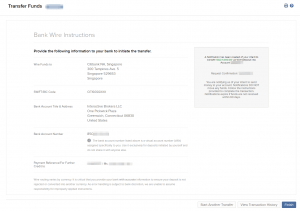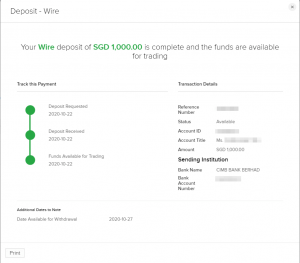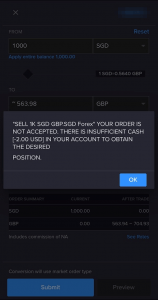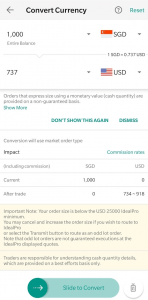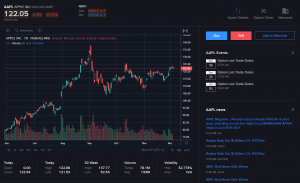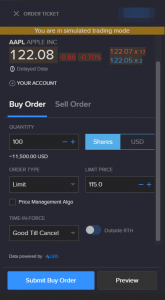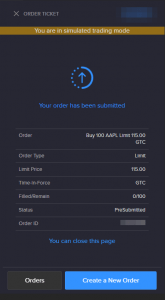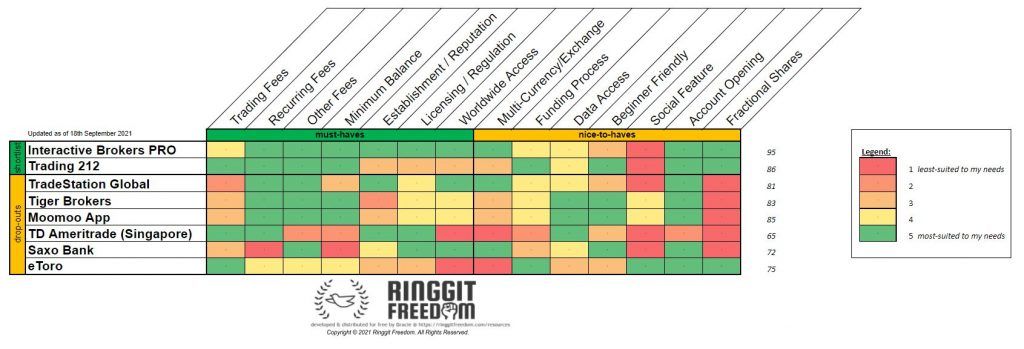The post Malaysian's Step by Step Guide to Invest in Low-Cost Index ETFs appeared first on Ringgit Freedom.
]]>I wish I had read about low-cost Index ETFs investing earlier - but I guess now is still never too late! This article will be aimed at those who want to get started with investing through investing in low-cost index ETFs but have no idea how to look for the right ETFs. Rather than telling you what to buy, we'll instead go through the few areas to look at before selecting the fund.
For me, the book that really inspired me to get into the whole shebang of low-cost index ETFs investing is the The Little Book of Common Sense Investing by John C. Bogle whom had democratized the low-cost index fund investing when he incorporated Vanguard Inc. P/S This article is NOT sponsored.
As always - let's first establish our basic understanding of exactly what is ETF before we start going around and scream WTFish!?!?
Table of contents
Index ETF!? I Need DEX 🤺 (to) Eat the Fish?! 🐠
Dexterity (DEX) nor the Fish has anything to do with Index ETF. Instead, ETF stands for Exchange-Traded Fund. As the name implies, ETFs are listed in our typical stock exchanges where we can trade (buy or sell) just like how we do with our typical stocks - usually with the same commissions/fee structure (and sometimes cheaper too!). Similar to Mutual Funds which are a more well-known counterpart, these funds will typically hold a basket of diversified stocks but have some key differences.
Both Mutual Funds and ETFs are typically created with a specific investment strategy/objective in mind, for example, a technology-stocks focused funds. However, the key differences between the two lies in where Mutual Funds are purchased directly from the Fund Providers (e.g. Principal, Kenanga, Public Mutual) and are actively managed by one or many fund managers with the goal to maximize profits.
Contrary, ETFs are listed in the Stock Exchange just like any other stocks, and can be purchased from any brokers (like Interactive Brokers) where invested funds will be used by fund managers to buy assets based on the initially set strategy, irrespective of market conditions. Fund managers passively manage the fund and do not make any trades to maximize profits, unless when the underlying index / fund strategy changes or when new capital gets injected where they will follow the existing allocation strategy to buy stocks. Ultimately, ETFs underlying assets (or NAVs) are basically a basket of stocks from different companies.
Okay.. what about that "Index" then!? Right... I forgot to explain that bit. The "Index" here is mostly referring to ETFs that primarily aims to replicate the performance of... an index, such as S&P 500. Take an example if I wanted to mimic (US) market's overall performance in my portfolio, without using any of my brain power - I could easily look up the list of Fortune 500 companies and buy all of their company stocks. Except this will probably cost me a bomb with at least 500+ transactions fees incurred.
A better alternative for me is just to buy up the market index, right!?!? Unfortunately I can't do that as market indices are merely "made up" to represent a specific segment of the market and its performance and hence came the "index ETFs" whose funds' sole objective serves exactly that purpose. Instead of buying 500+ separate company stocks like my previous example, I could have just made ONE SINGLE TRANSACTION and buy Vanguard S&P 500 ETF (VOO) instead to achieve the same outcome, with much lesser transaction fees.
With this one single trade alone, I have essentially bought the stocks of different companies like Google, Facebook, Amazon, ... and 490+ other companies in one single trade without incurring 500x separate trades required for such diversification (and along the way more transaction fees). This is especially great for the majority of the investors who may not be great for individual stock picking, and are lazy investors (myself included). As Warren Buffett once said,
A low-cost index fund is the most sensible equity investment for the great majority of investors
Warren Buffet
Now, you may be wondering: "If I wanted diversification, why not just go with Unit Trust/Mutual Fund and let the professionals manage the fund for me?"
Why DIY Index ETFs?
For many people, the idea of doing it yourself to buy Index ETFs can be both daunting and overwhelming. Amongst many of my friends/colleagues, when it comes to managing finances/money, one of the most common sentences that I have always heard time and time again is the following:
I don't know enough about managing money, so it's better off for me to leave it to the professionals.
Random Friends / Colleagues
The most common route that non-financially savvy folks will opt for, when it comes to investing after getting enough of the fixed deposits will usually be Insurance "Savings" plan and later, Mutual Funds/Unit Trusts. These are typically signed up through your friendly agents, friends or even relatives as some of them may already work in the financial industry. Whilst not all apples are bad nor people are inherently bad, the systems in Malaysia unfortunately does not help either.
Often, people don't even know what they had signed up for and blindly trusted their friends / agents. Who at least reads up the insurance policies before signing on the dotted line? I know I do. I don't want to repeat myself too much since I've ranted enough about these on my Getting Started - Financial Freedom for Malaysians! post, but in short from my perspective, the reasons to go for DIY Index ETFs instead of Mutual Fund/Unit Trusts or even RoboAdvisors ETFs are the following:
- Full Autonomy - you decide what you want and how you want to slice your (investment) pie
- ETFs Selection - with DIY approach plus international brokers with strong global presence, you open yourself up to more ETF choices and can tailor your investment portfolio to target specific segments where needed.
- Cost Efficient-ish - depending on your investment amount and cadence, you may (or may not) get to save more in the long run but generally it's much cheaper without the expensive annual AUM fees or transaction and other hidden fees
- Tax Efficient - DIY-ing also means that you can, based on your tax residency and residential country, to find the most tax-efficient route and avoid common US tax-traps!
- Simplicity - this may sound ironic but it's actually quite simple once you get the hang of it. You just need to make one transaction (or more) every other weeks / months / quarters / years - depending on your financial capability.
But of course, doing it yourself is not all rosy and beautiful. There's definitely more works to it as you can't simply have Direct Debit setup to directly deduct funds from your Maybank (or other Malaysian banks) and invest onto ETFs offered by some RoboAdvisors providers like StashAway. For most folks, I would still recommend to go for RoboAdvisors like StashAway as it's much more simpler and less headache for the less adventurous ones but for those who are willing, read on more!
Note that this article will not cover the transactional aspects of buying/selling the ETF 'stocks'. If you need guidance on that, feel free to check out my previous post on Beginner's Guide: Investing Abroad via Interactive Brokers from Malaysia as that's what I use to buy my ETFs.
How to choose the 'right' ETFs!?!? There's so many of them!
Picking an ETF can be a simple exercise - some closed their eyes blindly and purely follow recommendations from their favourite book's author, their favourite bloggers, or whatever's hot in the market today.
However, some would like to at least have some sciensy logic to it rather than doing it blind. Afterall, knowledge is power, isn't it?
Whilst I won't be able to cover every single aspects on this topic (as it's pretty broad topic afterall), I will point out some key considerations that I personally exercise when picking my ETF funds.
Strategy / Objective
As there are many varieties of ETFs, with "Index ETFs" being just one of those, you need to be clear on the selection of fund with its strategy/objective aligning to your personal investment goals.
Personally for me, since I'm going after low-cost Index ETF's, the fund's strategy must align as such with the sole purpose to replicate market index's performance.
Sectors / Geographical
Closely related to the above, the strategy/objective will usually also include a specific sector (i.e. technology, green energy, oil, etc.) or geographical area (i.e. US, Greater China, Asia Pacific, etc.). Depending on what your overall portfolio allocation plan, you may need to fine tune this to hit your allocation targets.
Personally for me, since I strive to maintain 30/30/40 between US/China/Others incl. Fixed Income or Gold; I mix in several broad-based ETFs and region-specific ETFs to increase my exposure to certain region.
Domicilation / Taxation
Probably one of the most important criterion amongst others - where the fund is domiciled (or "set-up" in layman term). In the end, the monies you invested will be used to buy underlying assets (e.g. Amazon stocks) so you will end up holding the same "asset". However, depending on where the ETF fund is domiciled at, your tax treatment may differ. Consult a tax professional to get advice on this one, or visit online sites like Bogleheads which has good information on this topic to avoid common US tax-traps.
Personally for me, since I'm a Malaysian Citizen and also a Tax Resident in Malaysia (they are two different things!), unfortunately this also means that I'm disadvantaged to directly hold US assets/stocks since there are no tax treaty between US and Malaysia and I'm better off to hold US assets indirectly through funds domiciled offshore, such as Ireland.
Currency Denomination
The currency used for the listed ETF. This one really do not have too much of an impact - in the end, whatever currency you opt for and deposit into the brokerage (and later fund provider) will be used to buy underlying assets, which are typically stocks listed in their origin exchanges/currencies. Most will opt for currency that works in their favour to reduce the number of currency exchanges to be done.
Transaction Fees
Remember ETFs are listed in the stock exchange, like any other stocks? You've probably guessed it then! Depending on the broker that you use, they may have different transaction fees based on stocks / ETFs purchased, and are also influenced by factors such as the Stock Exchange (i.e. London Stock Exchange charge more on average).
Personally for me, I am using Interactive Brokers since they provide me with global worldwide access, most importantly to London Stock Exchange where I transact for most of my Ireland-domiciled funds.
Expense Ratio (a.k.a Annual Fees & Costs)
Another important criterion here which directly affects the amount of fee you have to pay (usually per annum), deducted directly from the capitals held. Most low-cost index ETFs come with an expense ratio of approximately 0.15% to 0.50% on average, depending on fund provider, fund domicilation and fund size.
Personally I try to keep this as low as possible, but are usually limited by other factors such as fund domicilation / taxation.
Dividend Model (a.k.a Accumulating vs Distributing)
Some companies may choose to distribute dividends on a periodic basis, which essentially are cash given to investors. Since we are holding the company stocks via an "intermediary" (i.e. the index ETF), depending on the type of ETF we purchase - whether Accumulating or Distributing, the treatment of the dividends received will be different.
In a perfect scenario (where there are no transaction fees etc.), there are no differences as to which model you choose but in reality, since we'll be dealing with brokerages which will likely charge us fees for any/every transactions made, Accumulating is almost always better, except if you need the cash (i.e. during retirement years).
Personally, I opted for Accumulating funds where possible since I would like to avoid receiving small sum of cash in my brokerage account, and incur additional transaction fees just to "buy back" additional ETF shares. At least with 'accumulating' funds, the re-investment is done at fund provider level which bypasses my brokerage and saves me transaction fees.
Fund Size / Liquidity
Fund size simply refers to the amount of funds held in the ETFs, or in proper terms, assets under management. The large the fund size is, the easier it is for the fund providers / managers to optimize costs and bring down expense ratios. The lower the expense ratio, more people will be willing to opt for the ETF (vs. competition) and hence providing better liquidity for buyers/sellers to trade at fair value.
If the ETF has bad liquidity, often, the asking / bidding price on the stock exchange may differ from the actual Net Asset Value (NAV) of the asset, hence creating a disparity and resulting in a loss (or gain in some cases).
Personally, since I don't intend to trade often, I did not prioritize too much on this point so long as the fund size is of reasonable amount (hundred of millions or billions).
Tracking Accuracy
Another pretty important criterion, especially for index ETF investors. What's the use of an Index ETF if it can't even accurately trace an index? Imagine buying a S&P 500 Index ETF only to find out that its performance is nothing like the SP500...
Tracking accuracy is nothing, but as its name imply, how accurate the ETF is tracking the Index.
Phew, that's a long list of definition and explanation. It might be hard to digest everything at one go, so perhaps a better way to learn is to pick some real examples and go through them together to see how it works in action?
Example Scenario
For the sake of disclosure, none of the ETF's written on this post shall be treated as a recommendation. Please do your own due diligence and research before deciding on one. I am merely sharing real examples so that you can at least understand see how/what goes through my head when I was deciding for "the ETF(s)" that I had opted for.
Let's run through a scenario - say, I am looking to buy a broad market index funds like S&P500. However, we know that S&P500 are made up of 500+ US-listed companies with 100% exposures to the US market. From a quick analysis, I also found that my portfolio is already US-heavy, and I wanted more exposure into the China market (for better or worse...).
I can go for several approaches here:
- I can opt to select multiple index ETFs and balance amongst them in a specific ratio/allocation %, such as combining S&P 500 US funds and a Greater China Fund.
- I can ignore my worries and directly buy into S&P500 index funds only
- I can look up for funds whose strategy aligns with mine and has exposures beyond just the US market
Now that I have decided that pathway 3 may suit me better, I looked up various options and found that Vanguard Total World Stock Index Fund ETF (VT) may suit my need. Let's run through the few criterias that we discussed earlier.
| Ticker | VT listed in the New York Stock Exchange |
| Strategy / Objective | Total World Stock Index Fund seeks to track the performance of a benchmark index that measures the investment return of global stocks. |
| Sectors / Geographical | FTSE Global All Cap Index (global large, mid and small caps with exposure of 60% US and 40% other countries) |
| Domicilation / Taxation | United States |
| Currency Denomination | USD |
| Transaction Fees | Depending on brokerage. Since I'm using Interactive Brokers, at least a minimum of $0.35 per transaction and goes higher from there depending on transacted amount. |
| Expense Ratio | 0.07% |
| Dividend Model | Distributing (Quarterly) |
| Fund Size / Liquidity | Approx. $39.95B in Assets Under Management with average 1,260,516 trading volumes daily. |
| Tracking Accuracy | Almost 100% (visually), or R-Squared value of 1.0 (no tracking errors) |
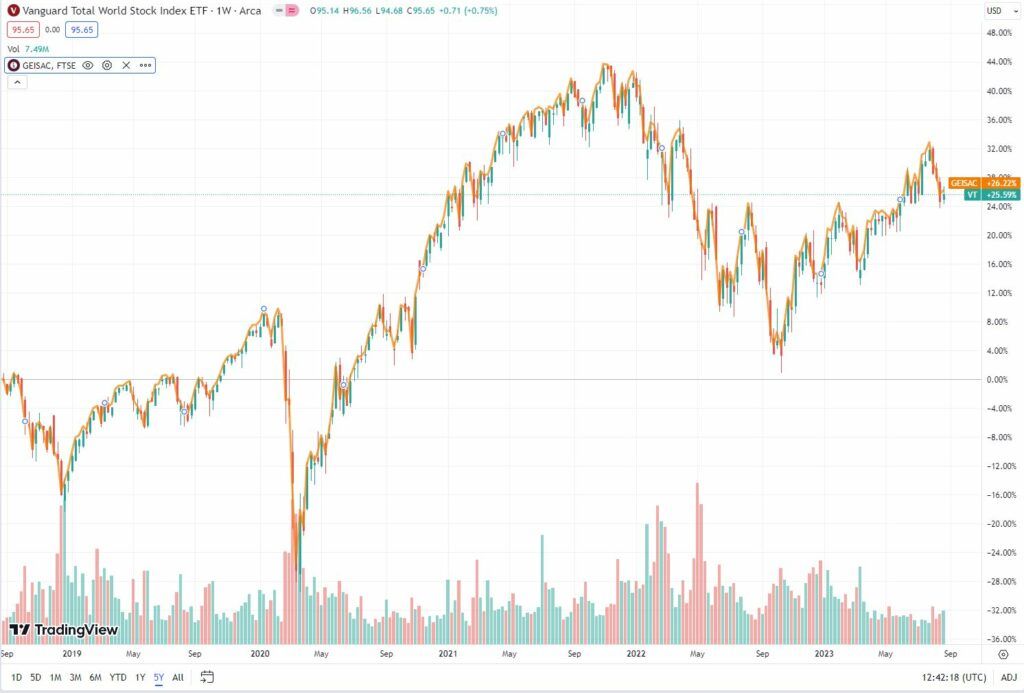
Now, where did I find those information, you may ask. I typically like to comb through multiple websites, primarily from the fund providers' provided fact sheet, Yahoo Finance, and also some ETFs-focused website as many of those information are already compiled.
After considering all these information, whilst I liked this ETF especially with the low expense ratio, I didn't like the fact that dividends are distributed (incurring me transaction fees to re-invest via brokers later) and the funds are domiciled in the US (which is disadvantaged for me) hence I had to look for an alternative. Maybe something of equivalent but domiciled elsewhere?
That's where I found Vanguard FTSE All-World UCITS ETF USD Acc (VWRA), and if you look at the facts below, it'll almost be dejavu except for underlined changes. It is basically a replica of VT, except for the stock exchange listed, fund domicilation, slightly higher expense ratio but with an accumulating dividend policy. Of course, this one have way lower average daily trade volumes and almost less than half asset under management but it'll do for now.
| Ticker | VWRA listed in the London Stock Exchange |
| Strategy / Objective | Total World Stock Index Fund seeks to track the performance of a benchmark index that measures the investment return of global stocks. |
| Sectors / Geographical | FTSE Global All Cap Index (global large, mid and small caps with exposure of 60% US and 40% other countries) |
| Domicilation / Taxation | Ireland |
| Currency Denomination | USD |
| Transaction Fees | Depending on brokerage. Since I'm using Interactive Brokers, at least a minimum of $1.70 per transaction and goes higher from there depending on transacted amount. |
| Expense Ratio | 0.22% |
| Dividend Model | Accumulating |
| Fund Size / Liquidity | Approx. $19.12B in Assets Under Management with average 48,276 trading volumes daily. |
| Tracking Accuracy | Almost 100% (visually), or R-Squared value of 1.0 (no tracking errors) |
And that's basically it! Going through all the steps above have helped me to finalize and shortlist VWRA as one of my favourite ticker as it meet most of my criteria - being globally diversified with exposures beyond US, tax advantages, rather-low expense ratio, and etc.
Unfortunately, not all index ETFs have sister listing in Stock Exchange / Fund Domicilation outside of home country - in cases of Greater China ETFs. So depending on your use case, you may / may not come across the "perfect one" that suits you. As with life, you just need to make the best decision that you can given the various constraints.
Wrap Up
I hope the above step-by-step walkthrough helps you to understand how to select and find your favourite low-cost index (ETF) funds. Always remember to come back to your investment strategy as that will ultimately fuel all your other decisions.
As always - thanks for reading and see you again in my next post! If you haven't already, be sure to follow me on my Instagram, Facebook and YouTube for latest updates!
Cheers,
Gracie
The post Malaysian's Step by Step Guide to Invest in Low-Cost Index ETFs appeared first on Ringgit Freedom.
]]>The post Beginner's Guide: Investing Abroad via Interactive Brokers from Malaysia appeared first on Ringgit Freedom.
]]>I wrote a comprehensive comparison of few of the key international brokerage players in my previous post: Malaysia International Brokerage Comparison, feel free to check it out on my thought processes before arriving on Interactive Broker as my primary (international) brokerage. After all, "Best" is a very subjective word and in the end it really boils down to what we want.
Now, if you have decided to go ahead and get started with Interactive Brokers, let's run through some of the basics to get you up and running to invest through Interactive Brokers. To keep things easier to digest, I will be trying to simplify some of the chapters (i.e. funding) as much as possible - with detailed breakdown potentially explained in a separate post (if required) just to avoid drowning those whom just want to get started with international investing.
For sake of clarity, the Interactive Brokers account referred throughout the entire guide below is the Interactive Brokers: PRO account - as the "zero commission" LITE account is only available for U.S. Citizens and not available for us Malaysians. Zero commissions are nothing but merely an illusion anyway...
I hope this guide will be useful enough to get you from zero-to-hundred in accelerating your progress towards investing internationally!
Table of Contents
- Why Interactive Brokers?
- Is "Interactive Brokers" approved by Securities Commission Malaysia?
- Opening Interactive Brokers Account from Malaysia
- Funding Interactive Brokers Account from Malaysia
- Navigating Interactive Brokers Client Portal
- What's Next?
Why Interactive Brokers?
I have actually done a pretty comprehensive comparison across quite a number of popular international brokerages in my previous post, but just as a quick recap on why Interactive Brokers are good for us Malaysians intending to invest abroad.
- Truly Global with access to 150 markets in 33 countries and with 26 currencies (as of the time of update)
- One of the lowest commissions players in the industry to trade Stocks and FOREX (with a real spot exchange rate and no markups)
- Low barrier of entry - No Minimum Holdings ($0) and ZERO inactivity fees ($0/month) since their update in July 2021
- Free Withdrawal (once per month) or $10 USD per withdrawal thereafter
- Acceptance of account funding through multiple countries, currencies and sources, including 3rd party transfers (e.g. Wise) - awesome for folks with overseas accounts like Singapore
- Regulated by US Securities and Exchange Commission and the Commodity Futures Trading Commission; and also a member of FINRA & SPIC in the United States of America.
- Well established since 1970s with strong investors' protection - a Broker You Can Trust for Financial Strength.
- Offers the lowest Margin Loan interest rates and paying up to USD 4.33% on instantly available cash balances in your brokerage account
With their extremely low commissions (and margin interest, for those up for it) - it makes it extremely cheap and efficient especially for long-term buy-and-forget investors like myself. Just to illustrate the point:
- for US-listed Stocks (min. $0.35 USD or $0.0035 USD per Share up to maximum of 1% trade value) plus clearing & exchange fees - too complex to summarise!
- for UK-listed Stocks (min. $1.0 GBP or 0.050% trade value) plus clearing & exchanges fees of approx 0.000045% trade value (or minimum $0.16 GBP)
- for HK-listed Stocks (min. $12 HKD or 0.050% trade value) plus clearing & exchanges fees of approx 0.007% trade value (or minimum $2.5 HKD)
- for FOREX (min. $2 USD or 0.00002% trade value) with the real spot exchange rate, no markups.
Most other brokers charge either a higher commission or hide some of the costs by marking up the purchase price, resulting in a lack of transparency for us investors. Personally, I am using my IBKR account with access to the London Stock Exchange to buy ETFs domiciled in Ireland, such as CSPX or VWRA, to have a slightly reduced Withholding Tax applied on the receipt of the dividends (15% instead of 30%).
If you are interested in the details, head to my previous post on the comparison between various international brokerages. And if you're still not convinced, check out IBKR's very own overview page summarizing their key benefits. Remember to look only at IBKR PRO plan!
Is "Interactive Brokers" approved by Securities Commission Malaysia?
NO!
Interactive Brokers is not officially established in Malaysia, hence they are not governed nor approved by our Malaysia's Securities Commission and all of our accounts opened will be regulated directly by the institution we opened our account in.
For those thinking to open an account through our IB Singapore (since it's the closest neighbour governed by MAS), sorry to tell you but unfortunately, we cannot select which of IB's entities to govern our account during the application. The entity is assigned based on our legal residence which in the case of Malaysia, our account will be opened directly under Interactive Brokers LLC in the United States.
This also means that in case shit happens, there's nothing that the Securities Commission Malaysia can do to help us, other than going directly to the international bodies (i.e. US Securities and Exchange Commission, Commodity Futures Trading Commission). However, this is not much of a concern for me - to be frank I am quite comfortable with international regulatory bodies as they're mostly pretty strict, if not more, than our counterparts.
So if you are not comfortable with international regulatory bodies - you have no other choice but to stick with local brokerages with hefty costs just to invest abroad (plus all the "handling charges" and unfavourable "currency conversions"). Unfortunately, I don't see this changing anytime in the mid-to-long term as Malaysia needs to protect our local brokerage to ensure local companies' survival. With our company's size and capital in Malaysia, how can we compete directly against a Fortune 1000 company on such a global scale?
But if you want to utilise one of the most cost-effective (and also international reach) brokerages, then read on!
Opening Interactive Brokers Account from Malaysia
Fortunately, the entire account opening process is very easy and you won't need to visit any banks or sign any paper forms. In fact, the whole process seems simpler than how I have opened my IBKR account indirectly through Tradestation Global back in October 2020 as there's no middleman involved here.
Sign-Up - Step 1: Initiate Sign Up
Firstly, you'll need an IBKR account. You can directly visit the Interactive Brokers' Sign Up page* and proceed to create a login account with your unique username and password, and also complete the email verification process. Only when you have done this, you can proceed with filling up the lengthy account application form.
Just head to this link* to get started on the application process. You may get redirected to different countries' website for Interactive Brokers, depending on their server. As of writing, I sometimes get redirected to either their Hong Kong, Australia, or their Global server depending on timing/connection. Nevertheless, it doesn't really impact your application process so long as you select your resident country accurately (i.e. Malaysia for most of us).
Again, it does not matter which IBKR server they route you to - as Malaysians can only have our account governed directly by IB LLC in the States.
Sign-Up - Step 2: Complete Application Form
Once your email have been verified, you will be redirected to a login page asking you to key in your earlier username and password in order to proceed with Completing a Started Application process. The form itself can be quite lengthy so set aside at least 10-15 minutes to do it quietly. If you have to leave half way throughout the process, that's fine - just remember to "Save" it so that you can resume later by logging into IBKR again using the link in your email or their homepage.
Application Form Overview
As the application form itself is quite straightforward (and lengthy), I won't go too much into all the sections in this post but instead, I'll highlight a few key points in the next few chapters and common mistakes to make sure you DON'T MISS IT. Just for a quick overview, below are all the sections you need to fill up before completing the application form. Now you know why I said could be lengthy...
- Customer Type (individual vs. joint)
- About You
- Contact Information (name, address, mobile) p/s last name is your family name; first name is your given name!
- Personal Information (date of birth, marital status, tax residency & tax identification number)
- Identification Details (identification document type, country of issuance, document number)
- Employment Details (employment status, employer details if applicable)
- Source of Wealth (where your monies from?)
- Account Base Currency (default currency used for some commissions deduction, reporting purposes, or to determine margin requirements)
- Security Questions (you'll need 3 of it. DON'T FORGET THEM!)
- Regulatory
- Account Type (cash, margin, or portfolio margin)
- Income and Net Worth (depending on your income and net worth level, you may be disqualified to access some of their product offerings)
- Investment Objectives and Purpose
- Trading Experience and Permissions
- Declaration & Reviews (W-8BEN, Tax Residence, Digital Agreements & Disclosures)
- Application Status
- Account Funding
- Mobile Verification
- Identification Document Verification
- Address Verification
Customer Type: Individual vs. Joint
For those married with spouse / partner, joint account might be an interesting option where both parties have equal rights to access / manage the account in the event of death of one holders. However, there might still be legal / tax implications or requirements surrounding the will process to avoid dispute and it is best to consult estate planning services.
As I am still single with only my mom as dependent (with sufficient cashflow elsewhere for my mom to inherit in the event of my death), my account was set up as 'Individual' customer type. For those with experience with 'Joint Account', feel free to share it in comments below!
About You: Identification Document
Whilst Passport is the "default" international document - Interactive Brokers seems to prefer our Malaysian NRIC as they can provide instant verification when you upload your identification document. I opened my account using NRIC without issues - irrespective of document you have selected, you need to submit photo of the identification document as part of the verification process.
About You: Tax Identification Number
There's always confusion when it comes to TIN. Some thinks that Malaysia doesn't have one but it is wrong.
All Malaysian / Tax Residents whom are liable to report personal income tax will definitely have TIN - it's basically your LHDN Tax File Number. Don't ever skip this otherwise it might be deemed as attempt to escape taxes (though we Malaysians are lucky to have 0% capital gain tax). Input the tax number as per your file without space (e.g. SGxxxxxxxxxx for my case)

If you have multiple tax residency, make sure you highlight them as well (e.g. in-between transition during a Short Term Assignment in a overseas position). If in doubt, consult your tax agents.
About You: Base Currency
This is another area most people (myself included) get confused. From my experience it serves mainly two purposes:
- Currency of translation for statements - for consolidated reporting purposes
- Currency used to charge some of the commissions (e.g. Currency Conversion commissions)
Personally, I pick USD as it is easier for me to manage (and also to do mental mathematics) - unless if one day MYR option appears there... If interested, you can read more about base currency here.
IMPORTANT: Remember your base currency - as it'll be one of the important point shown later during funding in / currency conversion processes
Regulatory: Account Type
There are 3 types of account type here: Cash, Margin, or Portfolio Margin. For most of us, the discussion is mostly "Cash" vs "Margin" as these are much more accessible option as compared to the "Portfolio Margin" which has high net-worth requirement (read more).
Generally, you should always go for Cash Account option - unless you know what you're doing. Again, to re-iterate, never ever trade with other people's money unless you know what you are doing. Leverage is a double-edged sword as it can amplify both your returns and losses.
Nevertheless, their Margin account is very attractive with one of the lowest interest rate and personally I switched my account to 'Margin type' sometime in February 2021. On cash account, you can only place "Limit Orders" utilising the actual cash positions you have - meaning you'll have a pile of cash sitting in IBKR account doing nothing and I hated that. I don't trade on margins, but I use the Margin facility to place imaginary limit orders with a very low/attractive entry price and will only replenish cash whenever orders are filled - typically during a market crash.
Regulatory: Trading Experience and Permissions
Choose the minimum permissions you need - you can always revisit and add more later. Personally I just went with Stocks for US (including Fractional Shares), Hong Kong, China, Singapore and most importantly United Kingdom (for my Ireland-domiciled ETFs!).
Note that they requires investor with at least sound knowledge before approving your trade permissions, and may restrict investors from getting access to higher-risk vehicles without proper experience.
Sign Up - Step 3: Complete Verification with Supporting Documents
Once you have completed all the forms and signed all the agreements, you should be able to see your application status page where you need to submit supporting documents, fund your account, or verify your mobile number.
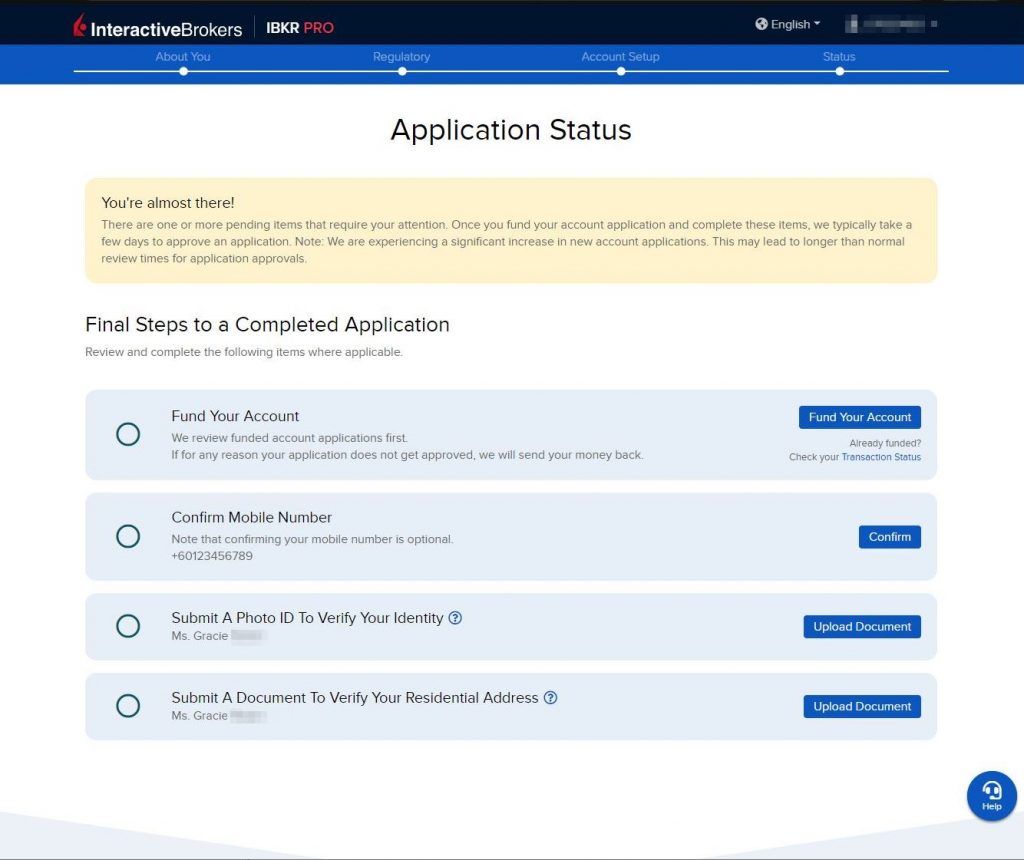
Depending on information provided earlier, there may be additional questions asked in this stage - for example, if they needed a better understanding on your income sources.
- Mobile Number confirmation - just SMS TAC verification to keep your account safe
- For Photo ID submission - as previously commented, just upload your NRIC front/back for their verification.
- For Address Verification - submit something else from credible sources with address clearly visible. They accept Bank or Credit Card Statement, Government-Issued Document/Letters (e.g. Drivers' License, Assessment Tax, etc.), Utility Bills (except Telco) or Property Evidence.
- p/s If you're thinking to use TNB - think twice. The bill is in Bahasa and if address are not spelt EXACTLY the same as your NRIC, you'll get headaches. Mine was rejected because of that and I ended up using Credit Card Statement from reputable international bank (HSBC).
- Account Funding - optional at this stage, but recommended to speed up the process. They review funded account first - see next chapter for details on funding processes.
From my personal experience, I funded my account to speed up the application process, but because of the 1x rejection (due to unaccepted address verification document), the entire application process took me close to 4-5 working days after resubmitting my address verification document (could've been shorter if I didn't get rejected to begin with).
Funding Interactive Brokers Account from Malaysia
There are 3 common methods used by us Malaysians to fund our international brokerage account:
- Method 1: Directly engage your bank's Foreign Telegraphic Transfer (TT) service from your local account (in MYR) to IBKR's international account (in world's major currency)
- Money Trail: Your Malaysia Bank > IBKR International Account
- Method 2: Transfer amounts from your local account (in MYR) to Fintech's account (in MYR), and leverage the Fintech to help complete the transfer (as the middleman) through Fintech's local account into IBKR's local account in world's major currency that you choose, (e.g. local Singapore bank account for SGD)
- Money Trail: Your Malaysia Bank > Wise Malaysia Account || trail disconnected || Wise International Account > IBKR International Account
- Method 3: Similar to Method 2, but passes through your offshore account first so that the inbound transfer into your IBKR is from your own name
- Money Flow: Your Malaysia Bank > Wise Malaysia Account || trail disconnected || Wise International Account > Your International Account > IBKR International Acco
If you don't plan to withdraw any amounts from your Interactive Brokers account any time soon, then the easiest way is just use Wise and perform the transfer into your Interactive Brokers account. However, if you choose this method, there will be a few days of holding period where you cannot deploy the cash after the transfer. You may also be subjected to audit in months down the road (up to even 7++ months) where you will be requested to provide evidence and paper trail of your fund transfers.
Alternatively, if you're lazy for random audits down the road, or wants to avoid the holding period, you can also opt to open a Singapore Bank Account (fully online!) by following my guide here: Opening CIMB Singapore account without visiting Singapore for Malaysians. This will allow you to then transfer from Wise to your offshore Singapore account, followed by a local transfer using your Singapore account onto Interactive Brokers' Singapore account under your own name denominated in SGD. Through this method however, you'll need to perform a currency conversion within IBKR itself which will cost you $2 in commissions - no issues with exchange rates though as IBKR uses near real time spot-rate as the conversion basis.
I generally prefers Method 3, since it helps to ensure that all deposits into foreign brokers will always be under my own name (to keep money trails clean). Whilst you don't need an offshore account to invest internationally, I strongly recommend you to open one in case of future withdrawals as it would be the most efficient way to withdraw from IBKR. If you haven't have one - Singapore is the easiest way.
Now, to keep this guide simple, I'll only be illustrating Method 2 below as it is simply the easiest way for beginners and works for almost all international currencies (e.g. USD, EUR, GBP, HKD, etc.).
The recent update since March 2023 with direct integration between IBKR and Wise has also made this even easier to only a measly 3 steps to complete a transfer at low cost!
Funding - Step 1: Open a Wise Account (first-time setup only)
You can sign up using my referral link here**. I won't go through the details on the account opening step-by-step as it is relatively simple - sign up, complete verification, and you're good to go! Note that you MUST open a Wise account for this simplified Method 2 to work as only Wise have direct integration with IBKR.
You can also opt for other fintech players like BigPay, InstaReM, etc. depending on your preferences. I personally choose Wise as they typically the fastest transfer with competitive enough rates for most of the time. Though sometimes other Fintech players may have better rates - so there's no harm to compare rates before your transfer especially if you are using Method 3.
Funding - Step 2: Enable IBKR-Wise Integration for your IBKR Account (first-time setup only)
Login to your Interactive Brokers account. If your account application hasn't been approved yet, you can see the "Fund Your Account" button in your Application Status dashboard. Otherwise, if you already have a fully-activated account, just log-in and access the "Transfer & Pay" section and find the "Transfer Funds" button and you'll see this shiny new button to Transfer from Wise Balance

If you haven't linked your Wise account with your IBKR prior to this, you'll see a prompt to login into your Wise account. Simply log in to your Wise account created earlier and follow through with the steps until your account is successfully linked to your IBKR.
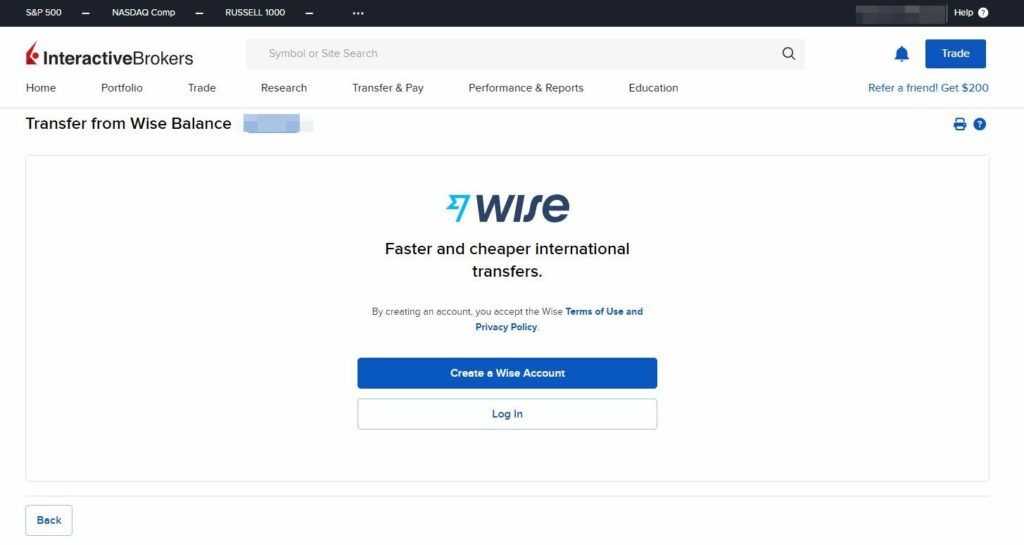
Funding - Step 3: Proceed with the Transfer from Wise Balance option in IBKR
If you have successfully linked your Wise account to your IBKR account, whenever you choose the Transfer from Wise Balance option, you'll automatically see your balances in Wise directly within the IBKR page.
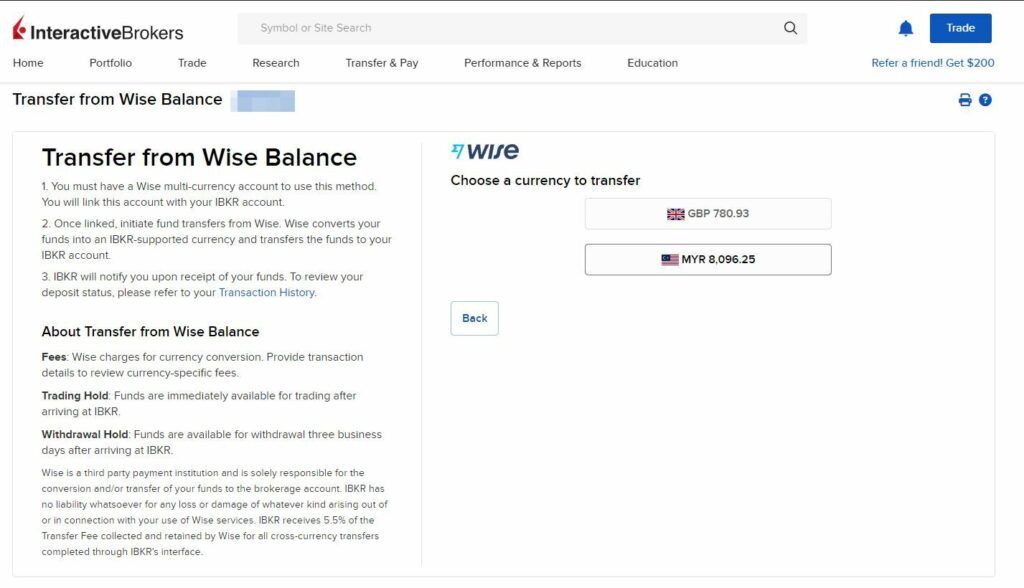
Ensure that you have enough funds in your Wise Account. If you don't have balances yet, just go back to Wise to initiate a topup via FPX (or any other currency). You can have balances in any currency as Wise will automatically do the conversion into your target currency. Personally, I top up directly into my Wise-MYR account.
All fees are handled on Wise, including whatever premiums that IBKR collects from Wise directly (approx. 5.5% premium on top of Wise's fee, inclusive). IBKR is not involved in this conversion process so they won't be charging you the $2 commission.
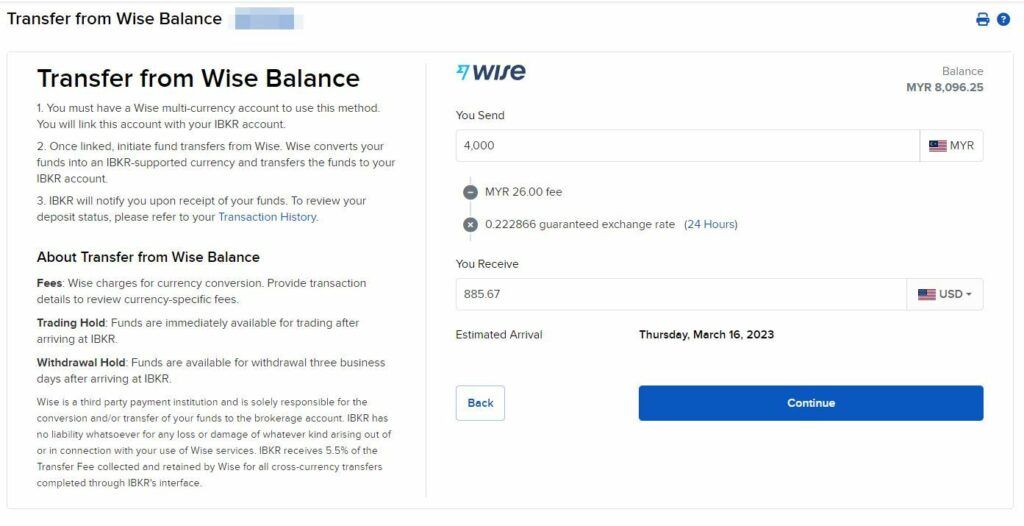
Yup. That's it, your transfer is done. If you take out the first-time setups, it's literally done in all single step within IBKR itself.
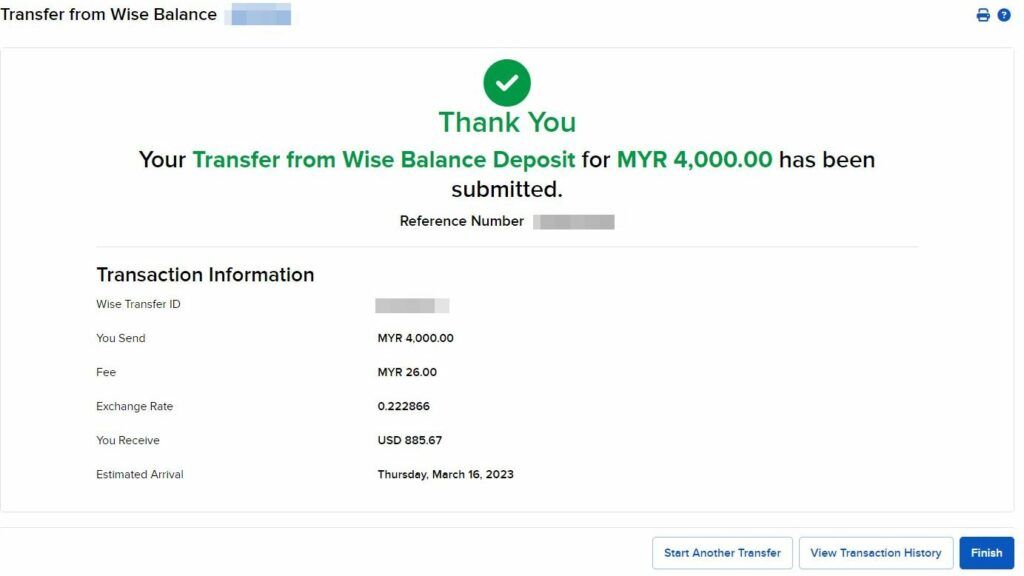
UPDATE 19 FEB 2022: With the recent Multi-Currency account made available for all Malaysians, another easier way if you opt for USD is just to enable Direct ACH Transfer for your Interactive Brokers account. Follow the similar step as above but select "USD" > "Direct ACH Transfer from your Bank" instead of the traditional "Bank Wire" method. This method is quicker as you don't even need to notify IBKR (aside from the first time set up!)
UPDATE 18 MAR 2023: With the recent addition of direct integration between IBKR and Wise, the steps to transfer are even easier and the article has been updated to reflect that. if you're interested still in the Direct ACH transfer, check out my other article here.
Navigating Interactive Brokers Client Portal
Login into Interactive Brokers via their homepage. Once your account is fully verified and approved, you will see a huge dashboard and hopefully without any errors (i.e. missing trading permissions). In case if there are some error messages, most likely your account setup has not been completed yet - perhaps wait for another business day (US timezone) and see how it goes, before contacting the IBKR Customer Support.
Account Pricing - Tiered vs. Fixed Pricing
When everything is ready, before you start trading - make sure to change your account pricing model to Tiered Pricing instead of Fixed Pricing as it works better for most of us unless your trade size is huge enough to leverage the Fixed Pricing model.
It's a very complex topic but the key difference between the two is where the commissions charged in Tiered Pricing is gross before adding the clearing fees and exchange fees; whereas in Fixed Pricing everything is already net inclusive of commissions, clearing fees, and exchange fees. If you want, you can do a detailed calculation using information on their pricing page here or search their examples here.
To check or change your account pricing model, head over to your 'Account Settings' page and then select the 'IBKR Pricing Plan' setting button
Once you are done, select your preferred pricing model. Personally I am using Tiered Pricing as it makes the most sense and are cheaper than Fixed Pricing, at least until when I have ultra-high net-worth and make big fat trades...
Currency Conversion
You can hold up to 26+ different currencies in Interactive Brokers, which was one of their strong selling point of dominant international presences. When you initiate a fund-in process, IBKR will store the amount you have transferred in its original currency. If the stocks / ETFs you intend to buy is different from your initially funded currencies, then you need to perform currency conversion within the IBKR itself.
To start the currency conversion within IBKR, just login to Interactive Brokers and select Convert Currency from the menu. Select the currency you currently own and convert it to your target currency, which will be used to purchase stocks / funds. Once confirmed, just submit the order and it will usually take a few seconds or minutes to fill-up the currency exchange order.

In case if you get some error message like "Your order is not accepted. There is insufficient cash [-2.00 USD] in your account to obtain the desired position." like below, then it means that your Base Currency do not have the sufficient amounts required to cover the FOREX commissions. So make sure to always fund your base currency first before anything else. Back then, I solved mine by converting some amounts into USD so that it has some balances to cover FOREX commissions.
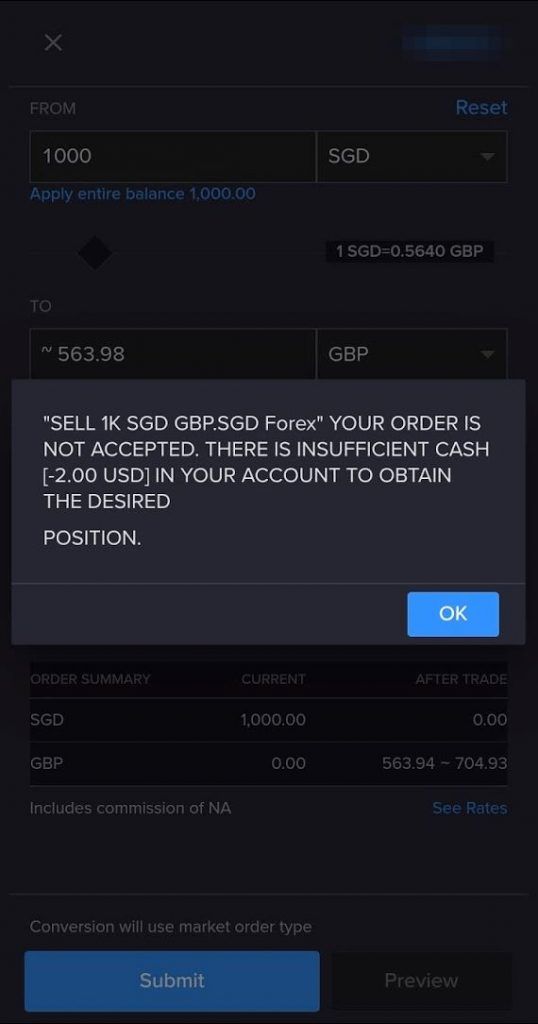
Buying Your First Stock
Once your account has sufficient funds (or if you're within margin limits), you can go ahead and place your order for your first stock (or ETF!). Buying stocks using their web app (or mobile app) is actually very simple - in 3 steps:
- "Search" the ticker symbol (e.g. AAPL)
- Hit "Buy" and input your desired quantity/order type/price/time-in-force
- And hit the "Submit Order" button and you're done!

What's Next?
I hope this guide have been helpful in your journey to get started with opening an international trading account, tapping into the power of Interactive Brokers. Frankly I'm grateful to be able to utilise IBKR sooner than imagined, thanks to their initiative to remove inactivity fees back in July 2021.
As you can see from My Portfolio, I am a strong advocate for passive and long-term investing through ETFs, and IBKR's global access with spot-rate currency conversions, plus its low commission / fees structure is really a blessing for me.
Thanks for reading and I will see you again in my next post! If you haven't already, be sure to follow me on my Instagram, Facebook and YouTube for latest updates!
Cheers,
Gracie
DISCLAIMER
This is NOT a sponsored post, but contains affiliate link where I may get rewarded when you sign up with my link and fulfils certain criteria.
* by using my Interactive Brokers sign-up link, you will be indirectly supporting my blog as I get a very small token of commission for every successful click by unique visitors.
** by using my Wise referral link, I will get 30 GBP for every 3 successful referrals when you complete your first transfer and part of the commissions will go to a non-profit community charity foundation.
PROMOTIONAL RELATIONSHIP DISCLOSURE FROM INTERACTIVE BROKERS
This content is provided by a paid Influencer of Interactive Brokers. Influencer is not employed by, partnered with, or otherwise affiliated with Interactive Brokers in any additional fashion. This content represents the opinions of Influencer, which are not necessarily shared by Interactive Brokers. The experiences of the Influencer may not be representative of other customers, and nothing within this content is a guarantee of future performance or success.
None of the information contained herein constitutes a recommendation, promotion, offer, or solicitation of an offer by Interactive Brokers to buy, sell or hold any security, financial product or instrument or to engage in any specific investment strategy. Investment involves risks. Investors should obtain their own independent financial advice and understand the risks associated with investment products and services before making investment decisions. Risk disclosure statements can be found on the Interactive Brokers website.
Interactive Brokers is a FINRA registered broker and SIPC member, as well as a National Futures Association registered Futures Commission Merchant. Interactive Brokers provides execution and clearing services to its customers. For more information regarding Interactive Brokers or any Interactive Brokers products or services referred to in this video, please visit www.interactivebrokers.com.
The post Beginner's Guide: Investing Abroad via Interactive Brokers from Malaysia appeared first on Ringgit Freedom.
]]>The post Interactive Brokers: Inactivity Fees Removed!? appeared first on Ringgit Freedom.
]]>- has at least USD100K in portfolio's worth
- generated at least $10 in commissions on a monthly basis - which requires at least 28 small trades (assuming 100 shares per trade)
After some digging, turns out that they've effectively eliminated the fees for good (at least for now...) as a measure to remove impediments for potential clients to maintain accounts with IBKR.
Removal of these conditions have sent some shock waves across various forums, blogs, or even in Reddit itself - not just Malaysia, Singapore, but also the European part of the world.
Frankly speaking, I was very sceptical when the news first broke out, as it seemed too good to be true but after digging around for a bit, it REALLY IS TRUE! I guess Christmas came early this year...
Table of Contents
- What's with all the Fuss!?
- Why Interactive Brokers?
- I’m already with TradeStation Global, What Now!?
- I’m new and wants to apply with Interactive Brokers, How?!
- Wrap Up
What's with all the Fuss!?
When I first decided to diversify from investing locally within Malaysia, into investing abroad across various international markets - one thing that frustrated me was that I couldn't find a PERFECT brokerage that suits my investing style.
I like to buy and forget, barely making any transactions on a quarterly basis, wants exposure beyond just the US with strong international bank account presences, and dislikes managing multiple brokerage account
That's how I first ended up with TradeStation Global - as the only reason was that dreaded inactivity fee from IBKR. With my current net worth and investment style, I simply cannot generate at least $10 in commissions on a monthly basis; nor I have a $100K USD worth of Portfolio to be eligible to waive the fees.
AND I WAS NOT ALONE! There's plenty of us on the FI journey who have opted for alternative brokerage house just for this reason alone.
The simple act of removing monthly fees with zero minimum balance has literally sent the shockwave to all of us - who was on the fence, with a strong urge to jump into IBKR's lap immediately.
Why Interactive Brokers?
While TradeStation Global worked very well as a painkiller, doing almost everything that Interactive Brokers does without the monthly fees; but indirectly we have to pay a slight premium for every trade that we make - i.e. minimum commissions of $1.5 for TSG vs $0.35 for IBKR.
Let's not also forget - the vanilla IBKR PRO allows their customer to activate for free the "Fractional US Shares" feature on their account, whereas the TSG users are not eligible to. Frankly, these are the only two potential key differentiating factors when comparing the two, since TSG holders have already long-enjoyed all the other perks that come with Interactive Brokers.
Just as a quick recap, any investors through Interactive Brokers (whether directly or indirectly via TSG) are already enjoying these features:
- Access to major stock exchanges around the world, including my personal favourite Ireland-domiciled funds on London Stock Exchanges (or China/HK-domiciled Funds on Hong Kong Connect)
- Strong international presence with several currencies supported (with bank accounts in the respective currencies' country)
- True spot exchange rate with zero markups on the exchange rate, with a low currency conversion fee of only $2.
- Flexibility in using 3rd Party Transfers such as Wise to fund their account (documentation/audit trail required!)
- Strong investors' protection and recognition across reputable regulatory bodies around the world - US, UK, EU, SG, HK, AU, and so on.
I'm already with TradeStation Global, What Now!?
I believe most of us have already, to a certain extent, already have the thought process to immediately jump-ship from TradeStation Global into the Interactive Brokers. As mentioned in previous chapter, the differences between the two are so minimal and really boils down to the following:
- IBKR PRO allows investor to activate fractional shares (for selected US stocks only)
- IBKR PRO have lower minimum-commissions per trade, at $0.35 for US shares (vs. $1.50 at TSG)
Should I De-link from TSG?
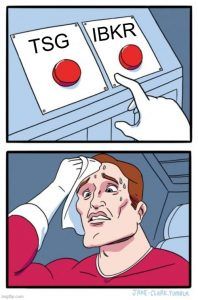
As with all decisions, it's always personal and up to you. What's most important is that the decision works for you - and here are some thoughts process that may help you to navigate through it:
Does your trade frequency / volume benefit from the low-commission rate?
IBKR's rate at $0.0035/shares with minimum of $0.35 per trade vs. TSG's $0.0070/shares with minimum of $1.50 per trade
How important is US-fractional shares trading to you?
Since the Fractional Shares trading feature only covers selected US shares, those of us whom are heavier into index funds domiciled in Ireland (or Hong Kong, in my case) will be out of luck
Do you need it NOW?
Competition is always good - as it pushes business into doing more things to acquire or retain customers. Perhaps, on the hindsight, IBKR would not even make this drastic decision if not for the likes of TSG (and all the new zero-commissions brokerage out there)
TSG's response have been subtle so far (by eliminating minimum funding requirement) - we'll never know what they may offer as part of their desperate retention strategy
What's My Decision?
I was still hesitating when I was preparing for this article - and writing definitely has helped me to better organise and crystalise my thoughts process allowing me to think deeper before jumping the gun.
On one hand, I want to switch immediately, as I have always wanted to apply with IBKR but wanted to save on the $10 monthly fees. On the other hand, I'm also curious as to what TSG will come out with, in desperation, to escape this unscathed. Especially since their secondary Unique Selling Point (or might even be primary), has always been the zero-inactivity fee with low-minimum funding but still having the near-full IBKR experience.
Of course, they still have their fancy desktop app, but that might appeal more to sophisticated traders and not retail investors like us. No matter how much I think about it - it seems to be an extremely sticky situation for TSG to be in as their current business model is to generate profits from the markup commissions.
If they are forced to commission-match with IBKR, that means their income source has to come from elsewhere - and I just cannot think what else they can offer at this stage except to tap into their proprietary software and also dedicated advisory support.
Looking back at the Brexit incident not too long ago where TSG had to handle a similar crisis - TSG was forced to introduce a monthly $15 Subscription Fee for their software after matching IBKR's default commission model. Even in that situation, it seemed to make more sense to stick with standard IBKR's $10 monthly fee (at that point in time, prior to the removal today) - unless you really want the software.
Given the outlook, I'm leaning more towards going ahead with the de-link since I don't see much maneuvers/cards that TSG can play from business model perspective.
Step-by-Step to De-Link TradeStation Global from Interactive Brokers
Thanks to the power of the internet, and various contributors ranging from my friend, Lowyat Forum, Reddit, most importantly IBKR FAQ - I managed to compile the below steps even before I completed the delinking process myself.
Below is a rough summary of what I have went through so to manage the expectations, for someone who were quite unlucky (compared to few others that I see in LYN forum)
- Saturday, 10th Jul 0100: Sent completed form to TSG, cc IBKR, with ticket lodged
- Monday, 12th Jul 2200: Email received from IB on verbal verification requirement
- Tuesday, 13th Jul 0030: Completed verbal verification by calling the Hong Kong number
- Saturday, 17th Jul 0430: IBKR "unlocked" with IBKR Pricing Tier, US Fractional Shares checkbox, and Refer a Friend functionality.
- Monday, 19th Jul 1502: Received message from IBKR indicating the completion of my account de-linking process.
- Tuesday, 20th Jul 1000: Verified Trade Confirmation Reports for 19th July and confirmed that TradeStation International Ltd is no longer reflecting in my account statements.
One key takeaway throughout this exercise is this: EVERYONE'S DE-LINKING EXPERIENCE IS DIFFERENT. Very odd for an institution which should have some sort of standardized processes to a certain extent.... But hopefully the below steps would still be useful as a reference to kickoff your de-linking journey, should you proceed!
Step 1: Request to De-Link Account via TSG Support
When you first send an email to TradeStation Global to request to de-link your account, they will share the below authorization form to fill up. To speed up the process, you can get a copy of this PDF here.
You must physically print it, sign it, and scan it back to them, together with your ID copy attached. Electronic signatures are NOT ACCEPTED!
I don't know if it's required, but I just kept keep [email protected] in copy when I sent the email.
Step 2: Notify IBKR to perform manual transfer review
Once you have emailed TSG on the authorization to de-link, you may proceed to notify IBKR through their ticketing system to perform a full manual transfer review so that you can complete the transfer from Master Account into Individual Account
2.1 Login in to your IBKR Web Client and go to "Message Center"
2.2 Submit a New Ticket
2.3 Search for manual internal transfer then go ahead and click on "Send Ticket to Client Services"
2.4 Make sure to select "Fund & Banking" and "Other Deposits & Withdrawals" as the categories.
As for the details, FAQ mentioned to provide old/new account number - I can't seem to find any different account numbers generated for TSG so I omitted that - will update back when I hear from IBKR team.
Step 3: Time for a Verbal Verification... better remember your Security Answers!
As I did both Step 1 & 2 pretty late on Friday night, I have probably missed Friday's train on the transfer verification processing. Thankfully the wait wasn't too long and I have gotten the verification request email on the subsequent working day during Monday evening (UK time).
All the email does is to ask you to call them to perform a verbal verification.
You will need the following details with you (at least in my case):
- Reference Ticket # (above email)
- Your Mobile Phone with App on standby (they may send a notification to verify via biometrics)
- IBKR Account # Number (Uxxxxxx)
- Current Master Name (TradeStation International)
- Full Name
- Date of Birth
- Birth Country
- Security Question #1, #2 and #3 (p/s if you forgot your security questions, take a look at this list and see if any of it rings a bell. Otherwise, you might have to reset it by sending it to the email listed in the form)
I have briefly summarized the processes that I went through.
3.1 Pick a Number and Call IBKR
I selected their Hong Kong ones (+852-2156-7907) as it's cheaper for me to dial Hong Kong than US via my company phone. In any case, it doesn't really matter as I called them midnight Malaysia time hence the Hong Kong agents was already out, and the call was automatically routed to US/Europe agents as they utilize Follow the Sun support model with 24 hours coverage.
There's a few greeting IVR's to go through and all-in-all I waited for approximately ~13 minutes (with good soft music choice). Below was the IVR menu that I went through, but may differ depending on timing/the number you called.
PRESS 1 FOR ENGLISH
PRESS 1 FOR EXISTING ACCOUNT
ENTER 7 DIGIT ACC NUMBER
PRESS 2 FOR TRANSFER-RELATED INQUIRIES
PRESS 0 FOR MENU
PRESS 3 FOR OTHER POSITION TRANSFERS - REMAIN ON THE LINE FOR LIVE AGENT.
From what I have gathered so far, it might be better off to just install Skype and and dial their US TOLL FREE number @ +18666942757. As a matter of fact, it might even be worthwhile to just install Skype app on your phone, save the number to the contacts, so that in case of emergency you'll be able to connect with IBKR, free of charge.
3.2 Once routed to a Live Agent...
Inform them of your intent to perform verbal verification, and provide them with the case reference number (in the email)
Before they proceed further, they will first verify your identity via mobile app notification. They will send a notification to your IBKR Mobile App and requests you to click on the notification to get verified using my phone's biometrics.
Following that, it's exam time! Just answer the questions listed in the earlier section.
I almost panicked when I forgot the answer to my 3rd question as I don't remember what was the answer I set. Gosh, why did I even set myself up with a security question that has multiple-choice answers!?!?!?
The problem for me was I had to take the call in an impromptu manner since I don't remember the security questions I have set during registration. There was also no way to warm up as the security questions set was not visible in IBKR Portal.
Thankfully I got it right after 3 attempts and the verification is then completed - I think the Agent was being nice to me since I answered everything else pretty much immediately, except the last security question.
The call was done in less than 5 minutes. At this juncture, all I was told is wait - no timeline, no commitment, nada. According to the agent, it really depends on the backlog/queue and it is hard to say now as he does not have visibility. In case of any updates, they will reach out again via IBKR Messages or Email so I was told to keep an eye on it.
Step 4: Now the hardest part... patience and wait!
From what I read online in various Reddit posts - this entire process will take at least 3 days (if you're lucky) or up to 3 weeks (which happened during the Brexit peak).
Looking at the current situation, I'd assume that we'll be closer to the peak period than the non-peak - since it's basically a crisis for TSG. Fortunately for me, the entire process took only approx. 8 days - which is also a mixture of late-submission hence missing the boat and/or being unlucky to go through verbal verification.
There are few ways to check the progress, with the easiest being the Home screen no longer censoring IBKR's logo and an additional "Refer a friend" tab appearing.
If you visit your account settings, you will also see a few options added where you can now sign up for fractional shares, select IBKR pricing plan, or visit your Refer a Friend page.
The last method that you can check on the progress is to run any report and check if the Account is still assigned to TSG as the Master Title. I'm still waiting for 19th July's Daily report which would probably only come by end of day US time...
And finally - my account is fully de-linked!
On the 19th July evening - I finally received a message from IBKR indicating that my account de-linking process have been successfully processed.
Verified it in the reports section and it is indeed not showing Master Account Title under TradeStation International Ltd anymore.
Just as a quick recap, below are what I went through but remember that everyone's experience may differ slightly depending on your luck (and the person handling your case) - so don't worry even if you went through a slightly different process than what I did. Most importantly is the outcome. Do share in the comments below your experience so that others can also benefit from it!
- Saturday, 10th Jul 0100: Sent completed form to TSG, cc IBKR, with ticket lodged
- Monday, 12th Jul 2200: Email received from IB on verbal verification requirement
- Tuesday, 13th Jul 0030: Completed verbal verification by calling the Hong Kong number
- Saturday, 17th Jul 0430: IBKR "unlocked" with IBKR Pricing Tier, US Fractional Shares checkbox, and Refer a Friend functionality.
- Monday, 19th Jul 1502: Received message from IBKR indicating the completion of my account de-linking process.
- Tuesday, 20th Jul 1000: Verified Trade Confirmation Reports for 19th July and confirmed that TradeStation International Ltd is no longer reflecting in my account statements.
I'm new and wants to apply with Interactive Brokers, How?!
You may refer to this step-by-step guide on Beginner's Guide: Investing Abroad via Interactive Brokers from Malaysia. The guide will basically carry you from zero-to-hero up to buying your first stocks successfully via Interactive Brokers. Or if you're lazy to read through articles and just want to brave through the process, here's the direct sign-up link* for you!
Why? Because TradeStation Global has always been using IBKR's backbone, and their role has always been an introducer with differentiation from product commissions/pricing perspective, as well as their in-house developed app.
Wrap Up
I hope this guide has provided you with a deeper insight on the whole saga from Interactive Brokers' decision to remove monthly inactivity fees from their product offerings, which opened up a whole new opportunity for some of us (especially buy-and-hold investors).
On the flip side, I personally feel bad for introducer brokers like TradeStation Global as they have been able to provide this service for years, by charging a slightly higher commission premium as their business model - and this decision definitely will impact them. I'm also wondering how much information was shared by IBKR to their business partners (introducer brokers) when these decisions were made...
In any case, it is a capitalist world and the fittest and agile ones may survive. Let me know what would be your decision - whether if you would stick with the existing TSG to see their counter offers, or to jump ship already to IBKR?
As always - thanks for reading and see you again in my next post! If you haven't already, be sure to follow me on my Instagram, Facebook and YouTube for latest updates!
Cheers,
Gracie
DISCLAIMER
This is NOT a sponsored post, but contains affiliate link where I may get rewarded when you sign up with my link and fulfils certain criteria.
* by using my Interactive Brokers sign-up link, you will be indirectly supporting my blog as I get a very small token of commission for every successful click by unique visitors.
PROMOTIONAL RELATIONSHIP DISCLOSURE FROM INTERACTIVE BROKERS
This content is provided by a paid Influencer of Interactive Brokers. Influencer is not employed by, partnered with, or otherwise affiliated with Interactive Brokers in any additional fashion. This content represents the opinions of Influencer, which are not necessarily shared by Interactive Brokers. The experiences of the Influencer may not be representative of other customers, and nothing within this content is a guarantee of future performance or success.
None of the information contained herein constitutes a recommendation, promotion, offer, or solicitation of an offer by Interactive Brokers to buy, sell or hold any security, financial product or instrument or to engage in any specific investment strategy. Investment involves risks. Investors should obtain their own independent financial advice and understand the risks associated with investment products and services before making investment decisions. Risk disclosure statements can be found on the Interactive Brokers website.
Interactive Brokers is a FINRA registered broker and SIPC member, as well as a National Futures Association registered Futures Commission Merchant. Interactive Brokers provides execution and clearing services to its customers. For more information regarding Interactive Brokers or any Interactive Brokers products or services referred to in this video, please visit www.interactivebrokers.com.
The post Interactive Brokers: Inactivity Fees Removed!? appeared first on Ringgit Freedom.
]]>The post StashAway Malaysia Review: Investments Automated appeared first on Ringgit Freedom.
]]>For those of you who have been following my investment journey, you will definitely notice that StashAway contributes a significant portion above 25% of my entire portfolio.
There are few good reasons for this, and today we'll be breaking down on how exactly StashAway have helped me to automate my financial journey. But before we do that, as always, let's at least first understand what and who StashAway Malaysia is about!
Table of Contents
- What is StashAway?
- How Safe is StashAway?
- Why do I like StashAway?
- Passive Investment Strategy
- Diversification, Rebalancing & Re-optimisation
- Automated Deductions
- Low-cost
- Goal-Based Investing
- What StashAway could’ve done better?
- Fees
- Processing Lead Time
- Custom Portfolios
- Wrap Up
What is StashAway?
StashAway is a Robo-advisory investment firm providing digital wealth services aiming to simplify investing, targeted at retail investors. StashAway was founded back in 2016 and headquartered in Singapore, but their initial product launch only happened almost a year later in July 2017 for Singapore and have since expanded into StashAway Malaysia since November 2018.

With the word "Robo" - most people can't help but think that there is some form of robot / artificial intelligence (AI) involved in making investment decisions to maximise profits for the client. This has to be one of the most common misconceptions people have with StashAway or any Robo-advisors for the matter.
While that may be one of the potential future direction for Robo-advisors to grow, in terms of technology in the distant future, the "Robo"-advisory in today's FinTech has not reached that stage and are mostly limiting its "Robo" use to risk assessment and consumer profiling, relying on consumer's input and a set of rather fixed algorithms.

These algorithms, on behalf of human-advisors, will then come out with some proposals on how much risk appetite the customer should be taking into account their current income, assets, liabilities, investment horizon, and goals.
How Safe is StashAway?
As with any other forms of investment, it will typically involve ones' hard work and savings so it's only natural to worry about the security of our funds - and whether if it is in good hands. Hence it's not surprising to see the below predictions when searching for "is StashAway ...." as the public may be concerned about how safe is their money with StashAway Malaysia.
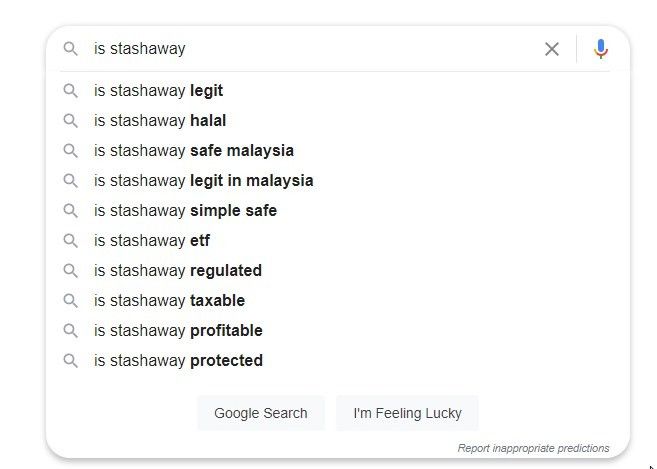
Fret not, StashAway Malaysia is regulated by our beloved Securities Commission Malaysia, granting StashAway Malaysia with the Capital Market Services License (CMSL) to provide fund management services to us, the retail investors. Just like any other financial institutions, StashAway is subjected to the same compliance, audit or reporting requirements.
Additionally, all of the investment funds that we have deposited will be managed by Pacific Trustees Berhad, in a completely separate account from StashAway's primary account. Even if StashAway ends up winding their business due to various circumstances, our investments will still be safe in the sense that StashAway won't be able to "zhao-lou" (run away, in Cantonese) with our monies.
In layman terms, StashAway only has access to their own finances (e.g. operational profits or expenses) and all investment funds are solely held by Pacific Trustees through their Citibank's trust account or SaxoBank's brokerage account.
The only right that StashAway is to manage the investment funds on our behalf, in accordance with our agreement in the Portfolios we have created. Order execution will be done accordingly through their brokerage (Saxo Bank) - and funds will then move from Pacific Trustees' bank account into the brokerage, with Pacific Trustees named as their beneficiary.
You can read more about StashAway's commitment to security here (for Malaysia) or here (for Singapore).
Why do I like StashAway?
Now that we know what StashAway is - let's dive into the five reasons why and how StashAway has helped me to automate my investment portfolios.
Passive Investment Strategy
Passive Investment Strategy is one of the main reason why I like StashAway so much - as they literally simplified my investment journey.
StashAway works by buying into Exchange Traded Funds (ETF), based on their target asset class / geographical allocation in their sophisticated investment framework - the StashAway ERAA® (Economic Regime-based Asset Allocation). The framework proposes a corresponding portfolio based on individual investors' selected risk appetite or goals, focusing on reducing risk exposures whilst maximising returns.
With this, StashAway took out all the needs for me to constantly check and monitor my portfolio, finding out when to buy/sell, or the need to rebalance manually when the asset ratio goes haywire. All I needed to do was to select the corresponding risk appetite or goals that match my profile and do my monthly top-ups a.k.a Dollar Cost Averaging.
Without the need to manage and constantly think/worry about all these, I get to focus on my day-to-day and less on my investment journeys as there isn't much "thinking" that I need to do, except when reviewing my investment strategy holistically (perhaps on a quarterly/half-yearly basis).
Diversification, Rebalancing & Re-optimisation
Since StashAway invests in a basket of securities through ETFs instead of individual securities, the portfolio will be well-diversified to protect investors from overexposure to any single securities.
StashAway's investment framework (ERAA) allows them to build an all-weather portfolio taking into consideration various economic factors; aside from just doing the traditional allocation such as 60-40 stocks-bond rule. Through diversification, each of these assets will its own target allocation (in %) based on the portfolio's risk index.
If any of the assets drastically rose/dropped due to market movements and resulted in an imbalance portfolio with weights beyond the original target allocation; rebalancing will then take place automatically through their systematic algorithms.
There are two ways rebalancing can happen:-
- For portfolios without frequent/recurring transactions, the rebalancing will sell some quantities of the performing assets (redeeming the profits) until it reaches the desired target allocation, then buy into underperforming assets (since it's "cheaper" now) so that the portfolio balances itself onto original targets.
- However, for portfolios with recurring/more frequent transactions, (e.g. recurring monthly deposits), the rebalancing may only happen at a later stage during the next purchase, by buying less of the performing assets and buying more of the underperforming assets.
The rebalancing would ultimately bring the portfolio back to its intended target allocation. These rebalancing activities, however, will only work if the underlying assumptions and target allocation remain unchanged. But what if the economics factor or underlying assumptions have significantly changed (e.g. after March 2020 COVID-19 Crash)?
StashAway also offers portfolio re-optimisation when such an event happens for individual investors to choose to opt-in onto the new target allocation or opt-out and remain with the old target allocation.
This has happened exactly in May 2020 when the team in StashAway decided that, based on their investment framework, to further optimise the portfolio exposures on various sectors/geographical areas.
If you are interested, you can read more on how StashAway approaches rebalancing and re-optimisation here.
Automated Deductions
For those of you whom are a salaried worker and are eligible to contribute to both EPF / Monthly Tax Deductions - do you usually give much thoughts about the auto deductions for EPF and Tax, or do you leave it as is maybe until tax filing seasons?
Chances are - most of us don't think about it as much. Because these deductions already took place before we get to see or touch the salary. This concept is very powerful and the only reason government does so is to ensure that you pay your tax dues, or forced-saving for your retirements, before spending it all. Imagine applying this to our personal finance journey.
This is where StashAway Direct Debit comes into picture - some absolutely hates it (after their last technical glitch) and some obviously loves it. I'm in the latter category. With direct debit facility offered by StashAway, it allows me to automatically deduct my bank account for fixed contributions immediately upon receiving my salary, or on dates I set it to be.
And after having auto deductions for more than 6 months (sitting at 21 months as of this article), my brain is already accustomed to not having that amount of money and eventually, it became a habit for me to "pay myself first" before spending, without even thinking about it!
The only exception here is where I need to put in some conscious efforts to make sure that I always review my "auto deductions amount" from time to time - to ensure that the deduction amount will always grow in tandem with the rate of inflation/merit increments. This way, I will be sure that I'm always taxing myself based on % of my income rather than a flat amount which may be insufficient in the long run.
Low-cost
For most of us when we first start our investment journey, our capital will typically be smaller - and any amount of fees (especially minimum charges) will eat up a higher % of our investments. Even though my total portfolio has already surpassed the RM100K mark, it can still be very expensive when I invest internationally if I don't pay attention to the fees.
As briefly explained in my previous post on investing internationally, cost efficiency matters especially when our capital is small. This is where StashAway truly shines as they allow us to invest any amount of capital (even if it's just RM10) with a bare minimum to near zero charges.
Just to illustrate the point, for every single "trade" (top-up) that we do, typically on a weekly or monthly basis, StashAway charges only:
- 0% upfront load / sales charge
- 0.1% on Currency Conversion (FOREX) with spot rate
Let's not forget the Fund Management Fees charged by StashAway on the total portfolio starting from 0.8% per annum, but this is true even for most if not all of the Unit Trust/Mutual Fund which typically charges at least 1.5% to 2.0% per annum, on top of other upfront load charges.
Of course, we won't be able to compare them apple-to-apple as both employs very different strategy (passively managed vs. actively managed) - but you get the point when it comes to fees, at least.
With StashAway, even if I am only investing a small sum on a monthly basis through direct debit, I do not have to worry about the fees associated, as compared to manually DIY-ing my Stock Picks / ETF purchases through my international brokerage which has a minimum amount for it to be cost efficient.
The frequency of investment/rebalancing, or the amount of diversification becomes an important factor as well - as these would rapidly ramp up the number of trades performed within a year. With StashAway, I can ensure that I can still tap into these factors without incurring additional costs - again due to the minimal fee structure.
If you are interested to further read on this topic, StashAway did a good job on the two articles below:
- https://www.stashaway.my/r/what-it-costs-to-invest
- https://www.stashaway.my/r/who-should-manage-your-investments
Goal Based Investing
Last but not least, this is one of my favourites and I really like how StashAway approaches investing in a more personalized manner. Most of us today knows that we need to save for our own future (though not everyone practices it, yet); but not many do so with a clear targeted goal when it comes to savings/investing - and I am definitely guilty for this.
In StashAway, there are two types of portfolios that we can create, with the first being General Investing, followed by Goal-based Investing - as you have probably guessed!
Through Goal-based Investing in StashAway, you would be able to create a targeted savings plan based on your needs, and StashAway would then adapt the investment risk according to your investment horizons. As an example - the risk appetite for Wedding Fund which will be spent within 5 years would be completely different than the risk appetite for Retirement Fund with an investment horizon of 35 years.
Currently, I have 3 portfolios in my StashAway -
- a general investment portfolio for my retirement funding
- a goal-based portfolio for my emergency fund in less-liquid form
- a goal-based portfolio for my project spending - my "no guilt fund" if I decided to spend it someday.
I'm thinking to add another goal-based portfolio for my future wedding fund although I'm still single right now ??. Who knows when I'll need to access the fund, better safe than sorry, right!?
What StashAway could've done better?
While I have been enjoying my journey with StashAway Malaysia automating my investment portfolios thus far - it is not all fluffy puffy without its own flaw.
These issues obviously are not enough to pester me to pull out from StashAway completely - but improving these bits would definitely improve the "satisfaction index", for me at least. Maybe most of these are just me picking bones from the egg...
Fees
It might be ironic to see fees listed in both my likes & dislikes, but it is the truth. While it is true that StashAway's fee structure is very competitive and put many of the actively managed unit trust/mutual funds to shame - I personally still find it to be on the high side.
With the assumption that the underlying funds' expense ratio will only cost us approx. ~0.20% to ~0.40% per annum, adding the fund management fee of 0.8% per annum will easily put the total fee between ~1.0% to ~1.4%.
This is only slightly lower than most unit trust/mutual funds with fees ranging from ~1.5% to ~2.5% per annum. Since the funds are passively managed, it would have been awesome if the fund management fee starts from ~0.5% per annum, lowering as the total investment goes up.
But then again StashAway also has a business to run and they're not a charity organisation, I guess there'll always be a trade-off point when it comes to these decisions.
The only reason that holds me back from going into 100% DIY ETFs is the cost efficiency without proper economics of scale. Through DIY ETFs, it is very difficult for me to achieve the economics of scale to make the fees (e.g. FOREX Conversion Fees, FOREX Commissions, Minimum Trading Fees) worthwhile when I make my monthly investment.
Also not to forget the need to diversify into various ETF holdings as well as the rebalancing activities, which will rapidly amplify the cost of investment. At this juncture, my monthly investment amount is simply not worth it to do DIY ETFs, unless when I pump in lump-sums from time to time due to bonuses/windfalls.
Processing Lead Time
One of my frustrating experience is the lead time involved when we invest through StashAway. In typical cases, the amount will only be invested approximately 2-3 days after our initial funding - from the "initial deposit" up to the point when StashAway ultimately "buys" into the underlying assets (ETFs).
While there should not be much of an effect in the long run considering that I typically do my "invest and forget" style, so technically one or two days won't really kill me. Still, it just annoys me at time when I do my monthly/bi-weekly checking to ensure my direct debits are deducted/invested correctly - and find that the amount is still "being processed".
Maybe I just got used to the same-day purchasing experience when it comes to DIY ETFs and it kinda spoilt me a bit. Thinking back, unit trust/mutual funds had the same issue as well (if not longer than 3 days).
Custom Portfolios
This might sound a little hypocritical - but sometimes I do wish that StashAway allows us to play around with some custom portfolios where we can have the freedom to choose the underlying ETFs at our own risk, outside of the EERA Framework.
This way, I get to run some "experiments" with my own custom portfolios whilst having StashAway's standard portfolios as my benchmark - since their portfolio will always leverage ERAA as their guiding principles for StashAway's investment decisions.
But again this defeats the whole mantra of StashAway - to simplify & automate investing. So I don't think StashAway will venture into this area anytime soon. Maybe I just need to find workarounds to do some A/B testing outside of StashAway, perhaps through my Trading212 account ?
Wrap Up
That's it for today! I hope that this article helps to provide you with some understanding of what StashAway is about - and also some insights into how I use StashAway as a tool to help to automate my investment journey whilst maximising my cost efficiency.
Is StashAway For You? It really depends. If you're someone like me who prefers to have a laid-back approach when it comes to investing (due to lifestyle, other time commitments, etc.), then it might be just for you as StashAway is really all about the passive-investing approach with the benefits of diversification, rebalancing, re-optimisation, and cost-efficiency already built into their offerings by default.
Having said that, even if we choose to go with StashAway, it is always important to understand how StashAway works and the underlying assets that they actually purchase. Never ever invest blindly and always strive to understand what it is (at least topline) before throwing monies in. Risk exists in all form of investments - especially those that we choose to be ignorant about.
If you would like to sign-up for StashAway, feel free to use my referral link* and get a 50% discount on the fund management fee for the first 6 months up to RM100,000 portfolio size.
As always - thanks for reading and see you again in my next post! If you haven't already, be sure to follow me on my Instagram, Facebook and YouTube for latest updates!
Cheers,
Gracie
* sign up with my referral link to get 50% off your management fee for the first 6 months up to RM100,000 portfolio managed! I will get a very small commission for every successful sign-ups - parts of it will go to charity!
The post StashAway Malaysia Review: Investments Automated appeared first on Ringgit Freedom.
]]>The post Beginner's Guide for Malaysian to Invest Internationally appeared first on Ringgit Freedom.
]]>With the rise of technology and FinTechs in the recent year, investing internationally is no longer as difficult/expensive as it used to be (say, 10 years ago) hence more the reason we should look internationally to diversify our portfolios.
This article is written to help beginners understand various ways to get started with investing internationally - but before we get there, let's first understand why we should diversify internationally!
Table of Contents
- Why Invest Internationally?
- Finding Your Investment Style
- Passive Investing
- Active Investing
- Methods to Invest Internationally
- Foreign Stock/ETF via Local Brokerages
- Unit Trust/Mutual Funds via Local Fund Houses
- Robo-advisors (StashAway/Wahed)
- Bursa-listed Foreign ETF’s via Local Brokerages
- Foreign Stock/ETF via International Brokerages
- Understanding Cost Efficiency
- Cost Factors
- Sample Calculations
- Wrap Up
Why Invest Internationally?
There are many good reasons why one should always look beyond just the domestic market - as the good ol' saying goes: "don't put all your egg in one basket".
Imagine if one day Malaysia becomes the next Zimbabwe and hyperinflation hits us and suddenly, all our years of hard work and our portfolio are essentially worth nothing now (okay, maybe a little too extreme, but you get the point)
Another factor is also that a significant chunk of our portfolio, through Employees Provident Fund (EPF), already has more than 70% exposed to local assets with only 30% international exposure.
Of course, this also depends on how long you've been in the workforce and whether if you're self-employed or wage earners, which will ultimately influence how much you've contributed thus far into your EPF fund. In my case, EPF makes up more than half of my total portfolio size and significantly affects my personal portfolio's investment decisions.
The next point is more relevant only if your style of investing is mostly passive than actively trading - which I'll further explain shortly in the next section.
Long story short, if you're a passive investor like me, then there aren't many choices left in Malaysia for us to tap into (e.g. ETFs aka Exchange Traded Funds) whilst still allowing a good average yield considering that our market has mostly been stagnant for the past 10 years.
As you can see in the above comparison of indices; whilst the US, China or Hong Kong Index have been seeing tremendous gains over the last decade, the likes of Malaysia/Singapore indices have mostly been stagnant.
That's not to say that we should not invest locally at all - but merely the strategy employed might differ from those we deploy internationally.
Finding Your Investment Style
Now that we know why one should always consider diversifying beyond Malaysia, there's another important concept that we must first understand before jumping into the 5 methods of investing internationally - and that is to first understand your own style of investing and find an investment strategy that works best for you.
While there has been a various form of investment strategies, they generally can be bucketed into two groups: passive investing or active investing. Both have their own merits and it is hard to argue which is better between the two - as what works for one investor may not work for the other so in the end it really depends on us as an individual.
Whilst this topic is not specific only to international investment, it is crucial to understand as most 'passive investing' generally works better in international markets like the US or China; compared to the Malaysia market which have very limited options (dividend or REIT stocks).

Passive Investing
Passive investing is the investment strategy that takes a longer-term / macro-view approach in which the investor typically minimizes the number of trades performed. Some also call this strategy the buy-and-hold or buy-and-forget style.
As part of risk management for this strategy, investors will typically diversify into several asset classes, geographical coverage, or industries. One of the most popular passive-investing methods is to buy a low-cost index fund that tracks overall market movement, a.k.a. the "average" market performance regardless of the market cycle (bull run vs bear market).
This investment style is suitable for investors who may not be able to allocate enough time to study the market dynamics and prefer to just ride along with the market average returns. For this strategy to work effectively, investors must be able to separate their emotions from their investments, and always take the long-term view when it comes to investing.
Whilst you will never be able to "beat the market" with this approach, you will be able to simplify and automate your investment as much as possible and also save on fees due to the lower number of trades whilst still ensuring enough diversification.

Active Investing
Active investing is the investment strategy that tries to capitalise on the opportunities created by the market fluctuations and maximises the profit leveraging the market volatility. Some prefer to call this the beat-the-market or timing-the-market style.
Unlike its passive investing counterpart, active investing sits on the opposite end of the spectrum which encourages the investor to make trades more frequently, buying into different asset classes (usually stocks) and selling them at the best timing to maximise the gain - also known as buying low, selling high.
This investment style is suitable for investors who prefer a much more hands-on approach to do their thorough research before buying into the asset, maximising their potential returns in the shortest possible time before moving onto the next trade as an attempt to "beat the market".
As the investors will also have to ensure that they get it right than wrong most of the time, and also to limit their potential losses in the event their judgement was wrong. This means that investors have to spend more time managing their portfolio and also performing more trades, resulting in more commissions paid.
There's no hard and fast rule on which investment strategy is better as everyone have their own preferences. As an investor, it is important to find a style that works for you - something that helps you to sleep comfortably at night.
Having said that, most studies suggested that passive investing works better for the general population; and only a very selected few that employed an active investing strategy actually have beaten the market.
For example, I maintain more than half of my portfolio under the passive investment approach through various ETFs and long-term stocks considering my risk appetite and also the amount of time I can afford to follow the volatility and movements of the market.
I do employ active investing on a very small portion of my portfolio, but rather than trading the stocks actively in the short term (<3 months), it will be held at least for the mid-to-long term (6 months to 2 years).
Methods to Invest Internationally
Now that we have learnt about the reasons to invest internationally and also the different investing styles that may suit us - let's hop into the actual methods on how we can invest internationally as Malaysians.
These methods will be sorted from the most expensive to the most optimal/cost-effective option for the majority of us Malaysians. As always, pick one that is best suited for your personal circumstances.
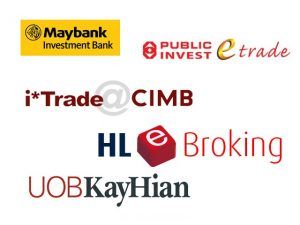
5. Foreign Stock/ETF via Local Brokerages
Not too long ago before FinTech disrupted the entire finance industry, this used to be one of the two common approaches when it comes to investing internationally in foreign stocks (with the other being unit trust/mutual funds).
Most of our local brokerages (e.g. Maybank2u, HLeBroking, ...) allows the investor to opt for additional service to access the Foreign Shares Trading, granting investors access to some of the well-known international markets (e.g. US, Singapore or Hong Kong).
Depending on brokerage, most charge around 0.5% commissions with a minimum commission of around $30USD - some higher, some lower. To add salt to the wound, since the foreign currency will be managed by your brokerage, you will also be at their mercy when it comes to foreign exchange rate and/or additional fees (if any, such as deposit fees, foreign trading handling charges, dividing handling fees, etc.).
These reasons combined are why people have the general conception that "it is expensive to invest internationally into foreign shares". An investment of RM500 with this approach is simply not worth it, as more than 30% will be paid to your brokerage due to the minimum commissions amongst other fees. And we're only talking about 1 transaction here - imagine diversifying ?.
Having said that, one of the (few) key advantages of going this route is to always have peace of mind since these brokerages are always regulated by Securities Commissions Malaysia - and you only have to deal with your brokerage throughout the international investment process.

4. Unit Trust/Mutual Funds via Local Fund Houses
Given how expensive it can get to purchase multiple "individual stocks" through the above method, many of us opted to purchase unit trust/mutual funds which essentially is a financial product that holds a basket of stocks as its underlying asset.
When we say unit trusts / mutual funds, most in Malaysia will probably be thinking about the Public Mutual fund house. Indeed - they are one of the most commonly known fund houses but definitely not the only one. There's plenty of other fund houses such as Principal Asset Management, Affin-Hwang Asset Management, Kenanga Investors, Manulife Investment Management, etc.
Aside from fund house themselves, there are also "one-stop shops" such as FSMOne (by iFAST Capital) or eUnittrust (by Philip Mutual) which offers most of the funds from a variety of fund houses except for Public Mutual funds (due to their in-house exclusivity).
Through this method, investors will be able to look for funds which has objectives aligned to the investors' goal, such as investing in foreign-listed companies / foreign-listed technology companies / etc. Whilst cheaper than buying individual foreign stocks through local brokerages, it can still get expensive when we add up all the fees over the long run.
Depending on whether if investor purchases directly from the fund houses' agent which typically has upfront charges of at least 3.5% to 6%; or purchasing from one-stop shops which generally have negotiated lower fees with fund houses (and passing on the savings to the investors) with upfront charges of only 1% to 2%.
On top of that, there are usually annual management fees charged directly by the fund, costing investors at least 1% to 2% annually (depending on funds and fund houses). Like other options, these fund houses are always regulated by Securities Commissions Malaysia.
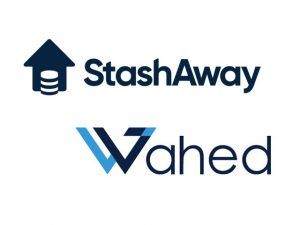
3. Robo-advisors (StashAway/Wahed)
One of the hottest trends in automating investing in Malaysia today is through Robo-advisors - such as the likes of StashAway or Wahed. In layman term, Robo-"advisors" tries to understand your high-level investment philosophy, investment horizons, and risk appetite to propose a portfolio allocation that works for you.
As the involvements required from humans are further reduced/eliminated, they will then be able to charge lower management fees at approx. 0.8% per annum. Additionally, most Robo-advisors today will invest in low-cost ETFs which generally have 0.1% to 0.4% expense ratios and all these will add up to be below 0.9% - 1.3% in fees per annum. It is relatively cheaper when compared to the likes of unit trust which are mostly managed actively by portfolio managers with above 1.5% - 2% fees.
One of the key advantages for Robo-advisors is the flexibility on the contribution amount with flat %-based cost, regardless of how much you put in. This provides greater flexibility for investors to automate their investments even if the monthly contributions are low, without incurring expensive fees.
For example, when depositing with StashAway via MYR, they charge only 0.1% upfront cost (attributable to the foreign exchange fees) with the spot exchange rate to convert it into USD to buy several underlying ETFs - up to 6 or more depending on the portfolio. It is almost impossible to achieve this scale of upfront cost even when performing DIY ETFs by yourself unless you earn in recognised currencies such as SGD/HKD/USD which can be deposited directly into some of the foreign brokerage without involving foreign exchanges.
With the simplified approach and minimal involvements required from the investor (aside from depositing money), it helps to simplify their investment strategy and this can be an advantage or disadvantage depending on the type of investors. For example, with StashAway you basically won't be able to do the "active trading" style, unlike the other methods.
Read also: My StashAway Malaysia Review: Investments Automated

2. Bursa-listed Foreign ETF's via Local Brokerages
Through Bursa Malaysia, there are already 13 ETFs listed excluding leveraged & Inverse ETFs, and about 8 ETFs has exposures outside of Malaysia - mostly focused on China Fund, ASEAN Fund, US Titans, Asia ex. Japan, and GOLD Tracker which you can find the latest list on Bursa Malaysia's website.
With these ETFs listed in Bursa Malaysia, investors will then be able to buy the ETFs using their local brokerage account incurring standard local fees, which is relatively cheaper when compared to foreign trading through local brokers.
While the options for the investor to choose from are severely limited, they can be a good start for those who may have limited capital; or do not want to deal with hassles of international brokerage/fund transfer - provided that the listed fund aligns with the investment objective of the investor.
Due to its extremely low volume, the price can be quite volatile at times and mispriced at a premium or undervalued compared to its underlying stock value (NAV). This is one of the many reasons why most of us decided not to invest in ETFs through Bursa Malaysia and have since decided to DIY through international brokerages.
Similar to the other options earlier, these brokerages are always regulated by Securities Commissions Malaysia - and you only have to deal with your brokerage throughout the process without involving foreign exchanges since it is already managed at the ETFs fund level.
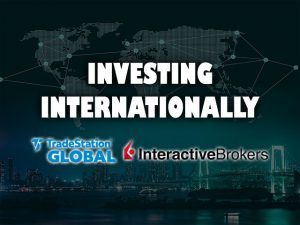
1. Foreign Stock/ETF via International Brokerages
In a nutshell, rather than buying foreign listed stocks / ETFs through our local brokerage which charges a variety of fees, it's so much more cost-efficient to buy it directly through an international brokerage providing direct access to these markets resulting in lower fees.
What's a better way to reduce cost than through direct ownership of the respective stocks or ETFs?!? Whilst true to some extent, it really boils down to the investors' style as well as their capital.
For passive investors or buy-and-hold strategy with stocks / ETFs, a brokerage that provides low commissions with coverage to the US, London and HK will usually suffice - as it provides wide enough coverage for funds domiciled in different countries to maximise the tax efficiency - I'll detail this in my separate blog post.
As for active investors who may make several trades in and out to capitalise on the market volatility, then perhaps brokerage who offers zero commissions with only US coverage will be more than sufficient, as this avoids the stacking effect of fees for every trade that we take.
Nevertheless, regardless of style, the potential will only be maxed out if you have a huge amount of cash to deploy - as the cost goes down when you inject higher upfront capital, reducing the overall cost incurred to your portfolios.
Before you jump straight into the bandwagon of the International Brokerages, make sure to read the following chapter where I briefly describe the cost efficiency for passive investing internationally.
If you want to get started with this method, check out a few of my other articles where I wrote about this topic intensively: Beginner's Guide: Investing Abroad via Interactive Brokers from Malaysia and Journey on choosing the 'right' International Brokerage.
Do note that none of these international brokerages are regulated by Securities Commissions Malaysia - unless they decide to open up their physical branch here.
Understanding Cost Efficiency
For any investment - cost efficiency matters. Period.
Depending on the cash amount that you have on hand, you may have to use a mixture of different investment methods spelt out above to achieve a "cost-efficient" investing.
Frankly, this topic is deep and can get very comprehensive technical just by itself, and I was initially planning to only write this on my separate post when comparing StashAway vs. DIY ETFs. But this important topic is often ignored by most so I decided to put this through together with this article earlier.
Fret not, what I'll do today is to at least summarise it in layman term with some calculations without going too crazy just to help you to grasp the concept of the entire cost of investments. For the comparison, I will be going in from the perspectives of a passive investor where the strategy is to minimize trades through a long-term approach.
Cost Factors
In general, when it comes to buying international stocks / ETFs through your international brokerage, the key considerations are typically the:
- Foreign Exchange rates & transmission fees incurred when transferring funds out from Malaysia
- Commissions incurred by the brokerage for Currency Conversion
- Commissions incurred by the brokerage for Trading/Transactions
This is why the investing strategy should always be personal depending on your investing style, capital, and time commitments.
Sample Calculations
Just to illustrate my point, if you invest only RM500 per month into 2 different ETF's via the "TradeStation Global / Interactive Brokers" route:
| Description | Cost ($USD) |
|---|---|
| Foreign Exchange Rates (Wise) | ~$2 |
| Currency Conversion (IBKR) | $2 (optional) |
| Trade Commissions (IBKR) - 2 ETF's | $1.5 x 2 = $3 |
| Annual Management Fee (IBKR) | n/a |
| Fund Expense Ratio (ETFs) | 0.1% ~ 0.4% |
|
TOTAL: |
One-Offs: $5 ~ $7 (~RM20.59 to ~RM28.83) |
- Wise: approx. $2 USD in foreign exchange transfer fees (assuming MYR > USD directly without going through own accounts, comparing TransferWise vs. Google Rate)
- For those who prefer to maintain a "cleaner paper trail" and also same-day transfer instead of delayed processing due to Anti Money Laundering checks, add $2 for IBKR spot-rate commissions incurred due to the additional steps for converting currency after funding through from your own overseas account (e.g. CIMB Singapore/HSBC Hong Kong)
- Trade Commissions: $1.5 USD per transaction - two ETF's will cost you $3 USD here.
- TOTAL FEES: $5 USD to $7 USD = ~RM20.59 to ~RM28.83
- or approx. ~4.12% to ~5.77% in total fees which is very inefficient - *cough cough* just like most unit trusts.
- We should generally try to keep it below ~1%
Compare that with another scenario, say, we accumulate at least RM5000 over X months then "move" the funds to perform the same trade above.
- Wise: approx. $8 USD in foreign exchange transfer fees
- Similar to above, add $2 if going through hoops
- Trade Commissions: $1.5 USD per transaction - two ETF's will cost you $3 USD here.
- TOTAL FEES: $11 USD to $13 USD = ~RM45.30 to ~RM53.53
- or approx. ~0.91% to ~1.08% in total fees
The above calculation is obviously over-simplifying things - as we haven't factored in the cost of diversification yet (see how in the examples we're limiting to only 1 or 2 trades per funding).
Unless you are able to consistently fund more than RM5K towards your overseas brokerage on a monthly basis, StashAway might be a more cost-efficient method for you when it comes to automating monthly investments.
Using the same RM500 as an example, the cost to diversify into various ETFs will be so much more efficient through StashAway:
| Description | Cost (RM) |
|---|---|
| Foreign Exchange Rates (StashAway) | Spot Rate |
| Currency Conversion (StashAway) | ~0.1% = RM0.50 |
| Trade Commissions (StashAway) - usually above 6 ETF's | RM0 x 6 = RM0 |
| Annual Management Fee (StashAway) | 0.8% |
| Fund Expense Ratio (ETFs) | 0.1% ~ 0.4% |
|
TOTAL: |
One-Offs: RM0.50 |
Of course, the above comparison is overly simplified as we are only factoring in the one-time upfront cost when DIY-ing our ETF purchases. There are also other factors to consider such as the amount of diversification, portfolio rebalancing, as well as annual management charges from StashAway (which is non-existent for DIY ETFs)
Wrap Up
I hope that you have learnt something today on why diversifying your portfolio internationally will help you in the long run. Always consider your personal circumstances to choose the most fitting option for you, and there's absolutely nothing wrong with mixing different styles or methods for your international investments!
One of the main driving factors behind your decision will likely be based upon your most optimal trade-sizes and duration required to accumulate enough funds to strive for maximum cost-efficiency when it comes to investing. I will be diving further into this topic in the future with more examples so stay tuned on my blog posts!
As always - thanks for reading and see you again in my next post! If you haven't already, be sure to follow me on my Instagram, Facebook and YouTube for latest updates!
Cheers,
Gracie
The post Beginner's Guide for Malaysian to Invest Internationally appeared first on Ringgit Freedom.
]]>The post Investing in International Stocks via TradeStation Global appeared first on Ringgit Freedom.
]]>TradeStation Global basically acts as an introducer for Interactive Brokers (IBKR), charging a slight premium in pricing tier / commissions, but leverages IBKR's existing backbone and infrastructure when it comes to trading and fund management.
As such, this post will be solely focusing on TradeStation Global and Interactive Brokers. In case if you want to better understand on my broker selection process, feel free to read my previous posting on my journey on choosing the "right" International Brokerage.
Whilst this guide is written with context for Malaysians, it is pretty much the same even if you're from other countries - perhaps with even better access to market or possibility of transferring fund without involving TransferWise / Foreign Transfers!
Without further ado, let's get started!
Table of Contents
- TradeStation Global Benefits
- Account Opening Process
- Step 1: Initiate TradeStation Global Application
- Step 2: Create Interactive Brokers Account
- Step 3: Complete Interactive Brokers Application
- Step 4: Submit Supporting Documents and Initiate Fund-In
- Step 5: Account Approved! Or not?
- Fund Management & Currency Conversions
- Interactive Brokers Deposit Notification
- Spot-rate Currency Conversion
- Buying Your First Stock
- What’s Next?
Why TradeStation Global for Malaysians?
UPDATE 9 JULY 2021: With Interactive Brokers removing the monthly inactivity fee, it makes more sense to skip TradeStation Global and just apply a native IBKR PRO account. Most benefits listed below are still applicable for IBKR, with addition of even lower commissions and fractional shares. Check out the article with step-by-step guide in opening an IBKR PRO account here: Beginner's Guide: Investing Abroad via Interactive Brokers from Malaysia
Just a quick recap, TradeStation Global was selected because of the following key benefits - which most of them were made possible thanks to their partner Interactive Brokers.
- Truly Global with access to 33+ countries, 135+ markets, and 23+ currencies (as of time of writing)
- Low Commissions in a nutshell
- for US-listed Stocks (min. $1.5 USD or USD 0.007 per Share)
- for UK-listed Stocks (min. $1.5 GBP or 0.12% trade value)
- for HK-listed Stocks (min. $20 HKD or 0.12% trade value)
- for FOREX (min. $2 USD or 0.006% trade value) with real spot exchange rate, no markups.
- Low barrier for Minimum Holdings ($0) and zero recurring inactivity fees
- Free Withdrawal (once per month) or $10 per withdrawal thereafter
- Acceptance of account funding through multiple currencies and sources, including 3rd party transfers (e.g. TransferWise)
- Regulated by Financial Conduct Authority (FCA) in the United Kingdom
- Well established since 1970's with strong investors' protection
Again, if you are interested with the details, head to my previous post
Account Opening Process
Truth to be told, the whole application process was very confusing for me at first. Throughout the journey I kept asking myself - "am I doing this right? I was supposed to open a TradeStation Global account but why does everything surrounding the form says Interactive Brokers? Why are there no email notifications?"
Although I was aware that TradeStation Global was merely an introducer, I did not expect that they are literally leveraging Interactive Brokers' backbone to such extent. Thankfully, their website have a good 5-steps summary which helped me to stay on track.
- STEP 1: Complete the TradeStation Global form to start your application
(UPDATE 9 JULY 2021: Skip this step if you are applying direct IBKR PRO account - which I strongly recommend) - STEP 2: Select your account type and create a username and password to start the Interactive Brokers application
- STEP 3: You will need to upload:
- ID card or passport
- Proof of address: Utility bill, bank statement or similar
- STEP 4: Receive your account approval within 48h and fund your account
- STEP 5: Receive your TradeStation Global platform download instructions and configure your workspaces (OPTIONAL)
For simplicity sake, I will re-sequence / modify some of the steps above to group things logically.
Step 1: Initiate TradeStation Global Application
You just need to head to TradeStation Global's website and click on Open An Account, which basically will present you with two options - to Create New Account or Link Existing IBKR Account
If you already have an existing IBKR account and would like to convert to TradeStation's commission model - do consult and check with TradeStation support just to make sure that the minimum holdings is now switched from $100K USD to $2500 USD (for monthly fees waiver) as I have no prior experience on this. But it does seem pretty simple and you only have one form to fill up.
For this guide, we will primarily be focusing on new clients so go ahead and click on 'Create An Account' and then complete the form via Open An Account page.
Upon submission, you should find yourself rerouted to Interactive Brokers website to complete the rest of the application process.
P/s in case if you’d like to support me, feel free to use my referral link to sign up and mention 'RinggitFreedom.com' in the registration form ("Where did you here about us?")
Step 2: Create Interactive Brokers Account
UPDATE 9 JULY 2021: With Interactive Brokers removing the monthly inactivity fee, it makes more sense to skip TradeStation Global and just apply a native IBKR PRO account. Follow this guide to learn more: Beginner's Guide: Investing Abroad via Interactive Brokers from Malaysia.
Once you've landed on Interactive Brokers site, there's only three things to do in this step.
Firstly, select your account type. This guide would be mostly focusing on Individual Investor like myself so go ahead and pick it. If you are registering as other account types, there might be subtle differences in the registration process but I believe it would be mostly similar.
Secondly, you will be routed to a page to create your username, email, and password. This is basically your credentials during the application process, and your trading account moving forward (upon approval)
Thirdly, you should receive an email by now to validate your email address, just click on it and it should complete the email verification process and viola! you have successfully created your IBKR account.
Note: Once you have created your username / password, REMEMBER IT! You will need it later to resume your application, or check on its status - by logging in directly via Interactive Brokers with the above credentials. This username / password will also be your key to access the trading platform after your application approval.
Step 3: Complete Interactive Brokers Application
If you have just completed the email verification step, there should be a login window for you to key in your username and password. Alternatively, head to Interactive Brokers website and click on Login - it's the same.
After logging in, you will need to select your investment account type - which in my case was Individual. One potential use case for Joint Account (which I hasn't explored yet) was to leverage it for estate planning purposes (read more).
I won't go too much into details here - it's just a tons of form to fill up. But instead, I'll highlight a few key points and common mistakes to make sure you DON'T MISS IT.
Tax Identification Number (TIN)
There's always confusion when it comes to TIN. Some thinks that Malaysia doesn't have one but it is wrong.
All Malaysian / Tax Residents whom are liable to report personal income tax will definitely have TIN - it's basically your LHDN Tax File Number.
Don't ever skip this otherwise it might be deemed as attempt to escape taxes (though we Malaysians are lucky to have 0% capital gain tax).
If you have multiple tax residency, make sure you highlight them as well. If in doubt, consult your tax agents.
Proof of Identification
Their preferred verification method for Malaysian seems to be our NRIC - which is good. Just select it and upload your copy of IC later.
Base Currency
This is another area most people (myself included) get confused. From my experience it serves mainly two purposes:
- Currency of translation for statements - for consolidated reporting purposes
- Currency where your FOREX commissions will be charged to (remember the min. $2 per conversion? more on that later.)
IMPORTANT: Remember your base currency - as it'll be one of the important point shown later during funding in / currency conversion processes
Trading Type
Always go for Cash Account option - unless you know what you're doing. Again, to re-iterate, never ever trade with other people's money unless you know what you are doing.
Leverage is a double-edged sword as it can amplify both your returns and losses.
Trading Experience
Choose the minimum permissions you need - you can always revisit and add more later. Personally I just went with Stocks for US, Hong Kong, China and Singapore. Note that they requires investor with at least sound knowledge before approving your trade permissions.
Make sure to double check and ensure that all your information populated are as accurate as it is - before you sign them off. Once you signed all the agreements, you'll automatically be moved to the Application Status page and no further modifications can be made at that point unless you contact IBKR support.
Step 4: Submit Supporting Documents and Initiate Fund-In
Once you have completed all the forms and signed all the agreements, you should be able to see your application status page where you need to submit supporting documents, fund your account, or verify your mobile number.
Depending on information provided earlier, there may be additional questions asked in this stage - for example, if they needed a better understanding on your income sources.
- Mobile Number confirmation - just SMS TAC verification
- For Photo ID submission - as previously commented, just upload your NRIC front/back for their verification.
- For Address Verification - submit something else from credible sources. They accept Drivers' License, Utility Bills (except telco bills), Bank Statement, Credit Card Statement, Passport.
p/s If you're thinking to use TNB - think twice. The bill is in Bahasa and if address are not spelt EXACTLY the same as your NRIC, you'll get headaches. Mine was rejected because of that and I ended up using Credit Card Statement from reputable international bank (HSBC). - Account Funding - optional at this stage, but recommended to speed up the process. They review funded account first - see next chapter for details on funding processes.
From my personal experience, with funding my account but 1x rejection (due to unaccepted address verification document), the entire application process took me close to 4-5 working days, which could've been shorter if I hasn't get rejected to begin with.
Step 5: Account Approved! Or not?
Of all the steps - this is the part which are the most confusing and frustrating for me.
On Working Day 5, my account was "approved" on Interactive Brokers side and logging in no longer shows me my Application Status page - but instead, redirects me to their homepage.
However, nothing was in the website and I cannot perform any activity, and my funds (previously funded during application process) is also not showing up.
The worst part was - I don't see the monies which I funded in
On Working Day 6, finally I received my second email - this time from TradeStation Global, giving me another username/password.
Took me awhile to realise - but this is basically for you to login into TSG Desktop Application should you choose to use their app (instead of IBKR Trader Workstation, IBKR Mobile Application, or IBKR Web Client).
When attempting to login directly to Interactive Brokers website, I still do not have trading permissions (and not able to login to mobile/desktop app)
Thankfully, at least it started to show signs that my monies are indeed there... Whew!
Between Working Day 7 to 9, frankly speaking I'm not sure which day, but my account is fully ready and I am able to convert currency and trade.
There wasn't any "official welcome email" or "completed account opening notification" which made the whole experience confusing.
Bottom line is - once you're able to login into IBKR Web and IBKR Mobile Application, with your cash "settled in", you're good to go!
Funding My Account
Before getting into the nitty-gritty of the fund transfers, let me first highlight the high levels on a few possible methods to fund your foreign investments:
In a nutshell, there are 3 common approaches when it comes to foreign transfers:
- Method 1: Directly engage your bank's Foreign Telegraphic Transfer (TT) service from your local account (in MYR) to IBKR's local account (in world's major currency)
- Method 2: Leverage Fintech money transfer services as the middleman to transfer from your local account (in MYR) to IBKR's local account (in world's major currency)
- Method 3: Similar to Method 2, but passes through your offshore account first so that the inbound transfer into your IBKR is from your own name.
I will dive into the details on the differences in above 3 methods in my future postings, but I generally recommend to avoid method 1 due to excessive foreign transfer handling fees and mark-up exchange rates.
Either Method 2 or Method 3 will be fine, as both relies on intermediary such as the likes of TransferWise or InstaRem providing competitive exchange rates (compared to traditional banks) to move funds across borders. You can also read more about it in my another blog post here: Wise vs. InstaRem? Which are better for Malaysians?
p/s in case if you'd like to support me, feel free to use my Wise referral code for free first transfer!
I generally prefers Method 3, since it helps to ensure that all deposits into foreign brokers will always be under my own name (to keep money trails clean). Whilst you don't need an offshore account to invest internationally, I strongly recommend you to open one in case of future withdrawals as it would be the most efficient way to withdraw from IBKR.
IBKR allows withdrawal to Malaysia Banks in MYR directly, but be prepared for hefty fees charged by intermediary banks together with marked-up exchange rates! One closest possible way is to withdraw through SGD via Singapore banks, before transferring back to Malaysia via TransferWise/FinTech - and Singapore happens to be one of the easiest way for Malaysians to open a Singapore bank account without leaving the country.
Personally, I have access to both Singapore bank account (as summarised above) and Hong Kong bank account (due to my previous expatriation).
Interactive Brokers Deposit Notification
Once you have decided the approach you'd want to take on funding your Interactive Brokers account, you simply have to notify them of a deposit, receive banking instructions, and complete the transfer within 60 days of notification.
If your account application hasn't been approved, you can see the "Fund Your Account" in your Application Status dashboard. Otherwise, if you already have a fully-activated account, just log-in and access "Transfer & Pay" section to find the same button.
Select your corresponding fund-in currency. I'll be using SGD in this example since it is one of the Offshore account that I currently own.
You'll be prompted to input the sender's institution details and your bank account number. Generally I'd also recommend to "Save bank information" so that I do not have to populate this information again in the future, as the account nickname/details will appear in my "Favourites" for immediate selection. Ensure that the amount input here will be an exact match to the amount you transfer later.
Once you have confirmed the details, a confirmation page will be shown alongside with instructions to perform the transfer. Never share the account details with anyone - as these are virtual accounts generated for you to perform the fund-in.
With the recipient bank details, you can now perform the transfer using one of the 3 methods mentioned above. In my case, I went with method 3 where I first converted my MYR into SGD from my Malaysia bank account to CIMB Singapore account (via TransferWise) and subsequently initiated a local FAST transfer within Singapore
Once the transfer is completed, you may check back on your "Transaction History" to check on the funding process. From my experiences in the past 1 month, the transfer generally takes within 1 - 2 working hours to reflect and you can typically start performing trades within the same day. Unless if your funds are withheld for future verification/audit checks, typically the case if you perform transfer under third party names (e.g. Method 2)
That's it! With the funds made available you can now proceed to trade within Interactive Brokers in whatever currency you have deposited (e.g. SGD in my above example)
Spot-rate Currency Conversion
You can hold up to 26+ different currencies in Interactive Brokers, which was one of their strong selling point of dominant international presences. When you initiate a fund-in process, IBKR will store the amount you have transferred in its original currency.
In above example, I have transferred 1000 SGD from Singapore Offshore account and IBKR held exactly the same amount in the same currency. Hence, if I need to purchase equities from US Stock Exchange (USD) or London Stock Exchange (GBP/GBp), I will have to perform an additional step of spot-rate currency exchange within IBKR itself (with commissions).
In case if you are worried that this "double currency conversion" will cost you more, don't worry. The amount is negligible thanks to IBKR's competitive spot exchange rates. I did a quick comparison sometime back in November and the differences are typically in the ranges of -USD0.5 ~ +USD2.5. These are really only negligible differences on amount you're getting between Method 2 vs. Method 3 of transfer methods.
To start the currency conversion within IBKR, just login to Interactive Brokers and select Convert Currency from the burger menu.
Select the currency you currently own and convert it to your target currency, which will be used to purchase stocks / funds.
Once confirmed, just submit the order and it will usually take a few seconds or minutes to fill-up the currency exchange order.
In case if you get some error message like "Your order is not accepted. There is insufficient cash [-2.00 USD] in your account to obtain the desired position." like below:
It typically means that your Base Currency do not have the sufficient amounts required to cover the FOREX commissions. So make sure to always fund your base currency first before anything else. I solved mine by first converting my SGD into USD to purchase my first set of stocks/funds, and left some USD for future FOREX commissions.
That's about it! Your account is fully funded, exchanged with the right currency which you want to trade in.
Buying your First Stock
Of the entire post today - this is probably the easiest step - as easy as A,B,C.
First, find your favourite stock ticker that you'd like to buy
Second, set your trading parameters such as Order Type (Limit / Market order), quantity and price. There's also option to set the order's validity (Day / Good till Cancel).
Submit and wait for order to be filled!
Obviously this is over-simplifying the advanced features that Interactive Brokers can offer on their latest Web Client, Mobile Application, and Desktop Application. In essence of time, I'll skip those for now and share more of it in my future postings.
What's Next?
I hope this guide have been helpful in your journey to get started with opening an international trading account, tapping into the power of Interactive Brokers with minimum holdings / fees via TradeStation Global. Personally I am very thankful to come across TSG-IBKR as their fees are really competitive, compared to local brokers both in Malaysia and Hong Kong.
In the future, I will be diving more into the process of using TradeStation Global / Interactive Brokers to provide more in-depth insights and guides based on my trading experience so far.
Thanks for reading and I will see you again in my next post! If you haven't already, be sure to follow me on my Instagram, Facebook and YouTube for latest updates!
Cheers,
Gracie
The post Investing in International Stocks via TradeStation Global appeared first on Ringgit Freedom.
]]>The post Malaysia International Brokerage Comparison appeared first on Ringgit Freedom.
]]>I hope that this written guide will help you to also shape your thoughts process to find the "right one" for you. I strongly believe that everyone's circumstances and priorities are different, hence there will never be a perfect one-size-fit-all solution, not in todays' world at least.
Table of Contents
- Why International Brokerage?
- Brokerage Selection Criteria
- My Selections – the “Dropouts” and the “Survivors”
- Interactive Brokers PRO
- TradeStation Global
- Trading 212
- Tiger Brokers
- TD Ameritrade (Singapore)
- Saxo Bank
- eToro
- Moomoo App
- Why Interactive Brokers / TradeStation Global?
- Account Application
- Account Funding
- Worldwide Recognition
- Establishments and Regulations
- Fees Structure
- Other Features
- What’s Next?
Why did I Suddenly Look for International Brokerage?
Truth to be told - I already have access to international markets and I didn't really need another one because I wanted to access US/Hong Kong/Global markets. I needed it for other reasons.
Prior to ending my short-term assignment in Hong Kong sometime back in 2017, I've decided to open up my Fundsupermart Hong Kong account which provided me first-hand exposure to Hong Kong & US Markets.
Back then, like many of us, I turned a blind eye to the fees calculation, assuming that HKD$50 per trade (Hong Kong) is cheap and fees wouldn't matter as much since I won't be actively trading overseas.
Maybe that was not the real reason - I was lazy - so lazy to to do my research during my last few months/weeks in Hong Kong and since I've been with Fundsupermart Malaysia for years, I decided to go back to them without second thought.
And I thought those fees were cheap...
It was a bad decision which costed me some monies, but thankfully not for long (again I wasn't actively investing overseas yet). I only found out this year when looking at my Cash Transactional History that there were "Dividend Handling Fees" charged for every dividend I have received. And the rate? HKD$30 for my Hong Kong stocks and US$2.50 for my US stock.

Whilst it was still "acceptable" for my Bank of China stock with approx. ~92% retained dividends; the same could not be said for my US stock where I merely retained ~8% of the dividends after fees and witholding tax (story for another day).
This got me thinking - there has to be some bigger brokerage house in Hong Kong, or International Market, which are willing to accept a small retail investor like myself but still providing competitive rates.
Frankly speaking, my filtering criteria is so strict that by the time I completed answering all of my own questions, there's only a handful of brokerage house remaining for my deep-dive analysis (less than 3) hence the decision was so much easier.
There are so many international brokerage out there!
I had to start somewhere, but it was truly overwhelming when I first tried to look for the one. So I decided to introduce some structured selection process which will also help my thinking, making a more informed decision rather than going only with my gutfeel.
My Brokerage Selection Criteria
Must-Haves / Preferably-Haves
- Trading Fees: Preferably $0 commissions or low fees (<0.5%) per trade
- Recurring Fees: Must have zero inactivity fee, no minimum trading fee, and zero monthly fees.
- Other Fees: Must have no other hidden fees (i.e. Dividend Handling Fee) or Withdrawal Fees (just in case if I have to liquidate my assets)
- Minimum Balance: Must have low barrier for entry (low capital)
- Establishment / Reputation: Established brokerage house with strong cash reserve / capital protection
- Worldwide Access: Access to US Market is a must with London-Exchange being a strong plus point (for Ireland domiciled ETF, long term holding). Access to other developed markets' stock exchange is a bonus (fees must be equally competitive)
- Licensing / Regulation: Licensed and regulated by reputable Monetary Authorities, preferably internationally recognised.
Nice-to-Haves
- Multi-Currency/Exchange: Built-in multi-currency holding with competitive spot-rate exchange rate is a bonus
- Funding Process: Preferably with options to fund via local bank accounts, other than direct international transfers
- Data Access: Real-time data, analysis reports, etc. are all a bonus
- Beginner Friendly: Preferably easy-to-use web (or mobile web) interface for beginner trading
- Social Feature: I'm always try to filters out the noises so not to get swayed by the public / sentiment / others' opinion when it comes to investing - so this feature is not crucial for me.
- Account Opening: Preferably easy (and fast) application process
- Fractional Shares: Access to fractional shares trading a bonus
To make my life easier, I have created an excel spreadsheet to compare all of the above criteria, giving a rating between 1 - 5 for each of the requirements with 'must haves' weighting double of the 'nice-to-haves'. If you are interested to do a similar comparison yourself, feel free to download/make a copy of the Brokerage Comparison Sheet.
After spending ten of hours comparing all the criteria above...
At a glance, you can see that I only shortlisted 3 potential options for my usage completely based entirely on my personal preferences, priorities and circumstances. In case if you are wondering on the scaling process for each of criteria (column) -
- First, I split my list of criteria into two buckets of "Must haves" vs "Nice to Haves" (as indicated in previous chapter)
- For each criteria, I individually assess them against my list of listed brokerage from 1 (least suited to my needs) to 5 (most suited to my needs)
- In the end, I will sum all the points allocated per brokerage house. For "Must Haves", the total score will be doubled (since it emphasises higher importance of having those needs)
Here's a little legend chart to simplify the explanation. Again, feel free to to download/make a copy of the Brokerage Comparison Sheet if you are interested to do a similar comparison yourself. In the end - you have to select the brokerage that FIT YOUR NEEDS the most, and not mine! There will never be a "one-size-fit-all" solution.
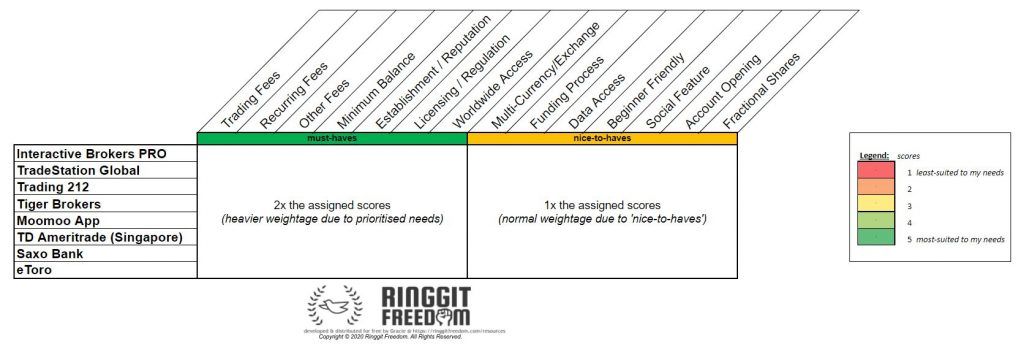
The Dropouts?
Before going to the shortlisted ones, I ought that most of you would be curious why are some of the popular choices amongst Malaysians are dropped?
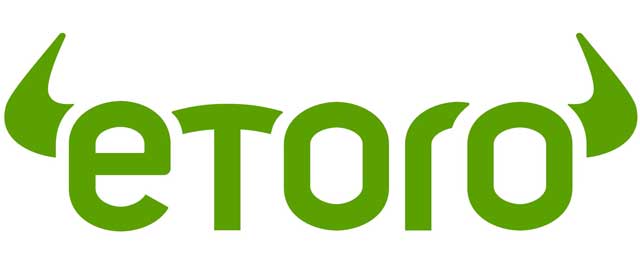
eToro
This was amongst the first choice that I have heard and looked into when I first started seeking out for international trading. The main reason of dropping it is simple - while they are being regulated by established monetary authorities, they lack worldwide access.
It may have worked if I were only looking for US-only trading but I am not - I have my Hong Kong portfolio which I plan to move out of Fundsupermart Hong Kong as previously explained.
They're also a fairly new player established in 2006 - innovation is good, Whilst they are regulated, but I want to be 200% sure when it comes to placing my money for long-term.
p/s if you're still keen to sign up and you'd like to support me, feel free to use my referral link to get free $50 upon successful deposit

TD Ameritrade (Singapore)
This was the second choice that I was looking into, after hearing it from colleagues of mine where she and her husband have been using thinkorswim by TD Ameritrade Singapore for a while and had good experiences.
Main reason of dropping out? Their hassle funding process - direct USD funding from own-account, leaving myself with no other choice than International Telegraphic Transfer which I absolutely loathed.
Another minor pain-point was the $3,500 minimum deposit and $25 withdrawal fees which I do not want to deal with in the future. Let's also not forget that their account opening is painfully slow, with some waiting for months since submitting their documents.

Tiger Brokers
This was really a tough choice for me to drop - I really liked their user-friendly interface, their lower-fees (except US stocks) when compared to TradeStation Global, and leverages the same backbone of Interactive Broker.
Main reason of dropping them? They're new player established less than 5 years ago and are still in the "investment / acquisition" stage and have just became profitable this year. Still, they're a strong contender and I will revisit them in years to come, but for now, I'll have to let them pass for the same reason I let eToro go.
Another challenge is how they deal with different currencies - regardless of what currency you choose to "fund" in with them, the destination is always in Singapore which means if we want to transfer funds (e.g. HKD) to my HKD bank account, I'll be incurring hefty FOREX fees imposed by the banks during the withdrawal process.

Moomoo App
While I liked the Moomoo App and have everything accessible within the mobile app - interactive & detailed charting, technical & fundamental analysis, integrated news aggregator, level 2 real-time data for the US market - whilst still maintaining relatively competitive commission models.
Unfortunately, due to my very specific needs of having investments in Ireland-domiciled ETFs through London Stock Exchange (as part of my long-term passive investment strategy), I won't be able to enjoy the Moomoo App at this juncture unless they decided to include LSE in the future.
Their presence in Singapore, with local bank accounts accepting inward SGD transfer have definitely helped to speed up all kind of investment funding, whilst keeping the fees incurred due to foreign exchange relatively low - by using our own Singapore account which Malaysians can easily open and Fintech services like Wise to keep all the cost low. Unlike some of the international brokers, at least we are not forced to go through telegraphic transfers from Malaysia just to fund our account and get slapped by expensive fees / unfavourable exchange rates aye?

Saxo Bank
Well - let's just say that the minimum deposit of $10,000 put me off almost immediately and I didn't even bother looking further (except for when compiling the chart above :P)
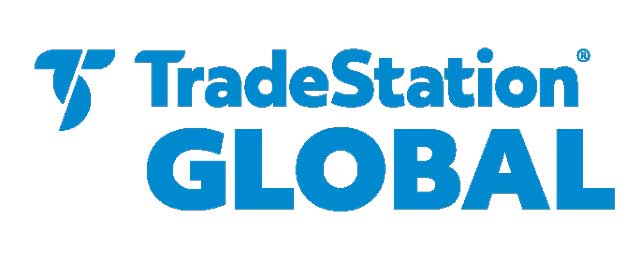
TradeStation Global
With the latest developments, I will be placing TradeStation Global as a KIV candidate - well, we never know when IBKR will go back on their words and start imposing monthly fees again.
Long story short, TradeStation Global is the introducing broker for Interactive Brokers, kind of like partner-in-crime if you put it that way. They are basically leveraging most if not all functionality (except fractional shares) which are offered by IBKR PRO, but with zero monthly fees or minimum deposit* required in portfolio size or cash equivalents.
VERDICT: Potential alternative international brokerage to hold all my core portfolios, positioned for long-term investing if IBKR PRO is no longer an option.
* UPDATE 18 DECEMBER 2020: Tradestation Global just increased the minimum holdings to USD2,500 effective 1 December 2020 for new customers.
* UPDATE 9 JULY 2021: Tradestation Global have also removed the minimum deposits required as a response to IBKR's latest developments. However, with IBKR removing the requirements for minimum deposit and monthly fees, the only reason to go for TradeStation Global is if you prefer to trade actively and prefers to use their TradeStation Desktop App since both does not charge monthly fees.
And The Survivors?
That leaves us with only 2 contenders and there's just no comparison anymore. When I first wrote this article back in 2020, there was still a further shortlisting process between IBKR vs. TSG but even that comparison is no longer relevant with the latest removal of inactivity fees from Interactive Brokers.

Interactive Brokers (PRO)
I liked this the most - as it ticks all of my checkboxes ranging from market coverage to low commissions. With the latest developments effective 1st July 2021, the dreaded monthly $10 inactivity fees are finally removed and it makes it a no-brainer choice for my brokerage decision.
With my semi-passive long-term investing style, this would be a perfect fit as most of my purchases would be buy-and-forget(hold) and only checking in once in a while, to top up or rebalance my portfolios.
One downside is - without zero commissions, even if I want to allocate a small portion for active trading (to learn new stuff), it wouldn't be worth the commissions paid.
The only reason I temporarily dropped IBKR back then was due to the $10 inactivity monthly fees as I didn't have $100,000 portfolio holdings yet, and I do not trade actively (<5 trades per quarter) - hence I have been going through the TradeStation Global route back then.
VERDICT: Primary international brokerage to hold all my core portfolios, positioned for long-term investing

Trading 212
You probably have imagined it already - this is where Trading 212 comes to the rescue. Whilst they are relatively new and established only in 2004, for a supplementary "active trading account", the risk appetite would be greater, since this would likely only attribute to <1% of my portfolio holdings.
With zero-commission trading, access to US stocks with Fractional Shares and zero-withdrawal fees, a minimum deposit of $1; this is perfect for my "playground portfolio" for some active tradings without incurring any fees. Plus, with their "Auto Pie" feature, I can basically create my own "Ringgit Freedom ETF" (which is basically a random mixups :P)
There are some downsides which I haven't figured out yet but I'll find out more in the future - concerns surrounding the process to fund the account with the lowest-possible-fees (since they have limited currencies support) or withdrawing from the account with lowest-possible-fees (since they only transfer to own-named accounts)
VERDICT: Secondary US brokerage to hold my playground portfolios, positioned for short-term trading. Though I won't be really active here as it is mostly for learning only.
* UPDATE 24 DECEMBER 2020: Trading212 just announced that effective from 4 January 2021, they will be introducing a lifetime limit on free deposits via all payment methods other than Bank Transfers. Deposits via these methods will remain fee-free until we have deposited €2,000 in total. A fee of 0.7% will apply thereafter.
But still... Why Interactive Brokers/TradeStation Global?

* UPDATE 9 JULY 2021: Although I have "disqualified" TradeStation Global in the latest update following the zero-inactivity fees from IBKR, the below section can still be interpreted if in the event we fall back into TradeStation Global someday - as the features are mostly the same with minor differences.
I know some of you would still be interested in some comparison in details, or explanations on why I went with the above choices. I'll try to address them in this chapter for each of the laid out categories, mostly focusing on Interactive Brokers (IBKR) as my primary broker for now (with TradeStation Global as backup in case if IBKR resumes charging for monthly inactivity fee)
How easy was it to open an account?
The whole process of opening an account with Interactive Brokers may seem daunting at first - but it's really easy, especially compared to the TradeStation Global's registration process which are slightly more tricky since it involtwo-party and the communication isn't clear at times. In both cases, all you need to do is just to fill up online forms, submit a few attachments to verify your identity & address, fund your accounts and you're good to go!
Back then, I had to open my Interactive Brokers account via TradeStation Global account (before the zero-inactivity fee announcement in July 2021), and it was so frustrating as there were several redirection, and no email notifications throughout the process until after the account was opened. Had I not paid extra attention to the progress and follow through by saving the link, username and password, I might not even be sure if my account was opened at all 😛
For those who'd like to follow a step-by-step guide, I have written a pretty comprehensive guide for both Interactive Brokers and TradeStation Global respectively - be sure to check them out!
How do I even fund my account?
Speaking of funding - you might have recalled my previous post of opening a CIMB Singapore account, and that was basically a precursor prior to me opening an IBKR/TSG account.
There are few ways to do it when it comes to account funding, but with my typical kiasi / conservative mentality, I decided to play it safe by ensuring that when it comes to paper trail, it is as clean as it get hence when given the options to fund my overseas investment account, I will always opt for own-name transfers whenever possible.
Example: My Personal Account > IBKR Account
The only time I'll be willing to use third-party name transfers are when I initiate transfers between my own accounts across different countries.
Example: My Malaysia Account > TransferWise > My Singapore Account or My Hong Kong Account
Doing it the safer way have a price to pay as well - since I need to incur double currency conversion, from Ringgit to Transit Currency (SGD/HKD), and subsequent funding it into IBKR and if needed, convert to another currency using their real-time spot rate, sometimes cheaper than what you see on Google.
Good news is - IBKR do accept 3rd party named transfer from the likes of TransferWise or InstaRem, though they reserves the right to audit your paper trail at random, so just be ready with your bank statements to prove the money trail if you happen to be audited by them.
For those who'd like to follow a step-by-step guide, I have written a pretty comprehensive guide for both Interactive Brokers and TradeStation Global respectively - be sure to check them out!
Worldwide Recognition for Currencies and Stock Exchanges
Since Interactive Brokers have been pretty established (more on that later), they have presence or office in some of the world's major markets - such as Hong Kong, Australia, UK, Singapore, US, etc., which also means that they will have a local bank account in those countries.
Whilst I'm not sure how broad is their presences for local bank accounts, one thing I am sure is both HKD and SGD local transfers are included. That basically means that I can choose one of two routes (Hong Kong or Singapore) if I ever need to fund my IBKR account, whilst paying minimal foreign transfer fees thanks to cheap international transfers via Wise.
This is mainly made possible thanks to their multi-currency holding (up to 22 different major currencies, incl. HKD and SGD), and a real spot-exchange rate with zero markup on exchange rate, though they will charge you a flat $2 per currency conversion.
For example, if I choose to fund my account through HKD,
- I will initiate a Transferwise from MYR to HKD, directly into my Hong Kong account
- Subsequently I will perform a local transfer, from my Hong Kong Account into IBKR's Hong Kong account using local HKD currency
- In IBKR, I can choose to keep these cash as HKD and use it to buy my favourite Hong Kong stocks; or choose to convert it to any other 20+ worlds' major currencies and buy stocks in those respective markets (e.g. GBP for Irish domiciled ETF; USD for US stocks), with real-time spot rate
Speaking of which, whilst they do not have access to every single stock exchanges in the world *cough* Malaysia KL Stock Exchange is not there *cough*; they have a respectable number of stock exchanges included. My primary ones for now would be US Stocks, London Stocks, Hong Kong Stocks and maybe Singapore Stocks.
How about their Establishments or Regulations?
For those of us whom opens an account directly with Interactive Brokers, the account would be opened directly under Interactive Brokers LLC in the United States and hence governed by the relevant regulatory bodies there such as US Securities and Exchange Commission or Commodity Futures Trading Commission. Note that the IB entity is assigned based on our legal residence which in the case of Malaysia, it will always be under IB LLC unless you have opened your account through other means (i.e. via TradeStation Global).
However, if you open your Interactive Brokers account through TradeStation Global (UK) as the introducer, you've probably guessed it - the counterpart is basically Interactive Brokers (UK) which both of them are regulated by Financial Conduct Authority (FCA) in the United Kingdom.
In both cases, our securities are held and managed indirectly by Interactive Brokers (in separate accounts from IB entity's book), and hence my primary focus will naturally be on them. You can check their financial statements here (UK) or here (US).
Here's my take in summary: They're cash rich, have no long-term debts, separates our assets from their company, and have survived through financial storms between 1978 - 2020, with strong guiding principles ensuring investors' protection.
One of the main reason why I decided to go with Interactive Brokers.
Let's talk about Fees
Now let's talk about the elephant in the room - Fees.
Fees have always been one of the top reasons which eats into your long-term profits, compounded. So if there's one thing that must be transparent, it would be the fee structure.
Just to quickly recap, below are the fees in a nutshell and you can visit the TradeStation Global pricing page and Interactive Brokers' pricing page to find out more.
- Trading Commission:
- TSG: typically at the range of ~0.12% or a minimum $1.50 depending on currency/stock exchanges, which are cheap.
- IBKR: definitely lower than above, or a minimum of $0.35 for US stocks. Pricing depends on currency/stock exchanges.
- Recurring Fees:
- $0 monthly inactivity fees for both IBKR/TSG*
- $0 minimum deposit for both IBKR/TSG*
- Other Fees:
- Withdrawal Fees: $0 for first withdrawal of the month, $10 thereafter
- Dividend Handling Fees: NONE
- Currency Exchange Fees: flat $2 per trade
It might be slightly confusing since there's two pricing tables/source but just remember this - if you applied via TSG, all pricing will follow TSG model, except if you took-on additional subscription / features from IBKR themselves. If you apply directly with IBKR, just follow IBKR's pricing which typically has the lowest. Remember to select Tiered pricing unless you trade in 6-digit USD every single trade!
Other Features
IBKR by itself operates on a "subscription model", providing everyone with essential / basic access to its core functionalities such as delayed quote, fundamental reports and analysis, access to use Desktop App / Web App / Android App / IOS App, etc.
For everything else optional or nice to have, such as Level 2 data (real time quote / stock charts per stock market), they offer it as an ala-carte add-on subscription. Kinda like Netflix (basic) plan providing you access to view / stream on one device, allowing you to go up in functionalities as you pay more, except that it is on ala-carte basis hence providing you with more freedom. if you want Netflix (4K) but only 1 device, you cannot - since it is already bundled in their 4K package.
If you are applying via TradeStation Global as the introducer broker, there will be some limitations set by Interactive Brokers preventing you from accessing some of the features - and the only one I have noticed so far is Fractional Shares being disabled in our accounts.
I will elaborate more in the in-depth Interactive Brokers' guide in my future postings but for now, let's just say that their web-application and mobile-app is actually not too bad.
Definitely not the most fluid User Interface (UI) / User eXperience (UX), but good enough for me to navigate on my own without watching any videos or tutorials.
What's next?
Phew.. this have really been a long post. I always thought that it will be a short one but I just can't stop adding more of my thoughts, but I hope that this have provided you at least with some insights on how I rationalised on my selection of international brokerage, before finally landing on Interactive Brokers as my primary choice of brokerage (with TradeStation Global as a backup in the event IBKR reactivates their monthly inactivity fee). I still keep my Trading 212 as my supplementary active trading for US markets/DIY ETFs via Pie Feature
As with all things in life, do your own comparison and find out what's best for you - as your circumstances, preferences, priorities or thresholds may be different than mine. Regardless of which, I hope that the general selection criteria would still be able to help you to choose.
Here are some of the detailed walk-through which might be useful for you to kickstart your journey:
- If you want to open a direct IBKR account, which is what I'm using now - be sure to check out the latest article Beginner's Guide: Investing Abroad via Interactive Brokers from Malaysia with comprehensive step by step!
- If you are still interested in opening a TSG account - be sure to check out Investing in International Stocks via TradeStation Global with comprehensive step by step!
- This post was significantly updated on July 2021, as the latest news from Interactive Brokers: Inactivity Fees Removed!? have pretty much changed the playing field.
Thanks for reading and I will see you again in my next post!
If you haven't already, be sure to follow me on my Instagram, Facebook and YouTube for latest updates!
Cheers,
Gracie
The post Malaysia International Brokerage Comparison appeared first on Ringgit Freedom.
]]>


